|
2025-12-24: Acknowledgement of M. Farle
Prof. Farle has been ranked by ScholarGPS.com as No 4 worldwide in the category of magnetic anisotropy. This result is based on a “revolutionary AI-driven search experience ... ScholarGPS celebrates Highly Ranked ScholarsTM for their exceptional performance in various Fields, Disciplines, and Specialties.” According to AI the scholarly contributions of Prof. Farle have placed him in the top 0.05 % of all scholars worldwide in listing of 2025 ScholarGPS. It is based on an AI analysis over his lifetime career: Highly Ranked Scholar - Lifetime.
You can also view the profile of University of Duisburg-Essen to discover other Highly Ranked Scholars as well as the rankings in various Fields, Disciplines, and Specialties.
|
|
2025-11-21: New publication in Acta Materialia: Tailoring structure, morphology, composition, and magnetism by Ag addition to CoCrFeMnNi–Agx (x = 0; 1; 2.5; 5.5 at. %) high-entropy alloy powders prepared by high-energy ball milling
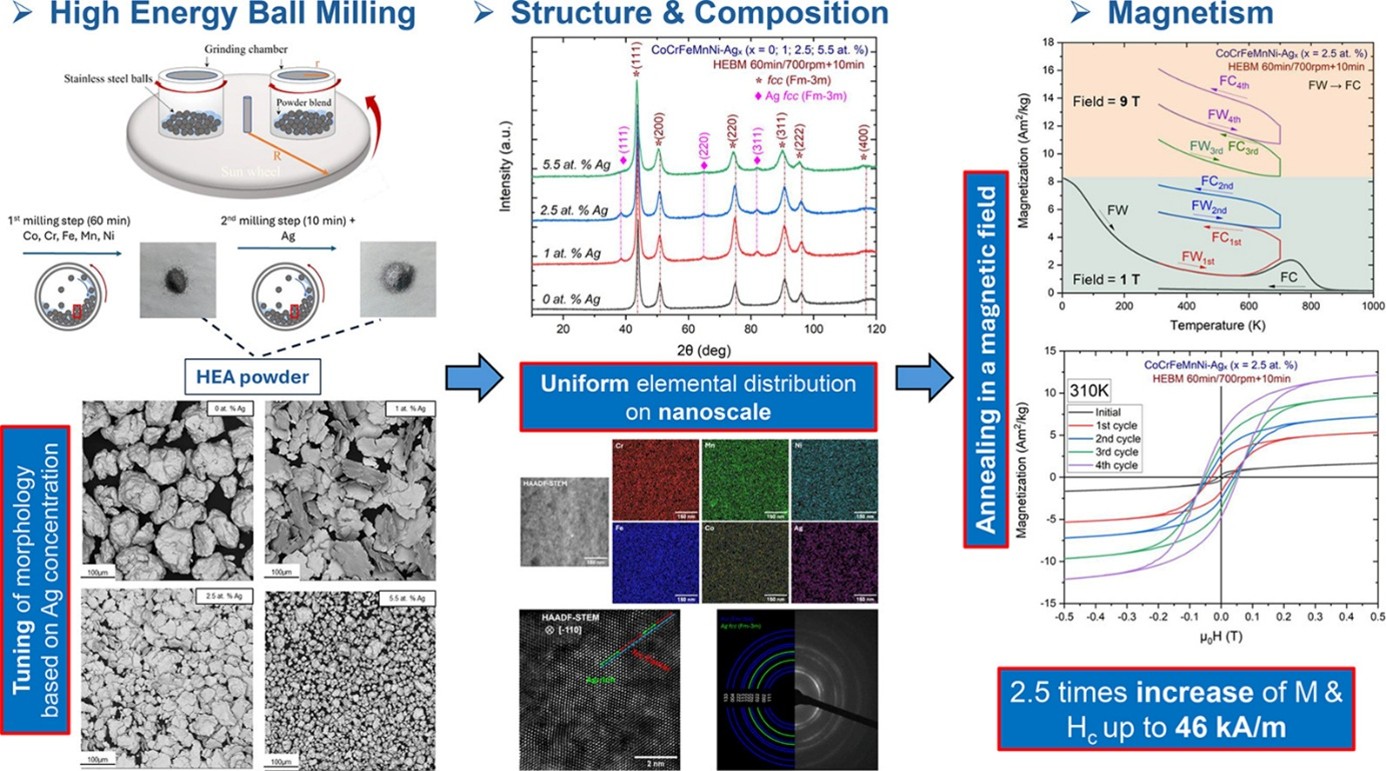
|
We have successfully synthesized nanocrystalline high-entropy alloy (HEA) powders for the first time through a rapid, two-step high-energy ball-milling (HEBM) process in Ar. A single-phase fcc Cantor alloy with uniform elemental distribution was obtained after just 60 min of HEBM from an elemental powder blend. Subsequent HEBM for 10 min with Ag addition enabled precise control over Ag distribution and particle morphology, which evolved from flake-like structures with Ag-rich edges (x = 1; 2.5 at. %) to homogeneous spherical particles (x = 5.5 at. %). All compositions exhibit paramagnetic behavior at 310 K, with Curie temperatures (Tc) decreasing from 96 K (Ag-free CoCrFeMnNi) to 71 K (Ag = 5.5 at. %), indicating suppression of magnetic ordering. Importantly, annealing up to 710 K in a magnetic field significantly enhances the magnetic response across all compositions. The CoCrFeMnNi–Agx (x = 2.5 at. %) HEA shows the most pronounced improvement, with magnetization (M) (9 T, 310 K) increasing 2.5-fold to 16 Am2/kg, coercivity (Hc) reaching 46 kA/m, and remanence of 4.8 Am2/kg. Notably, M approaches ∼ 1/3 of pure Ni under the same conditions, while exhibiting a Hc nearly two orders of magnitude higher.
These results highlight that Ag alloying and thermal treatment offer an effective approach to tuning magnetic properties in CoCrFeMnNi-based HEAs without compromising structural integrity. The ability to tailor structure, morphology, and magnetism through a scalable route promotes Ag-doped Cantor alloys as promising candidates for multifunctional applications requiring combined structural and magnetic performance.
https://doi.org/10.1016/j.actamat.2025.121717
|
|
2025-11-04: Iron-cementite (Fe-Fe3C) "core-shell" magnetic nanoparticles
In a German, United states, Russian and Armenian collaboration 20 nm sized particles embedded in a carbon matrix were synthesized via solid-state pyrolysis of ferrocene and structurally and magnetically characterized. The efficacy of magnetic hyperthermia as a function of nanoparticle concentration, as well as the frequency and amplitude of the alternating magnetic field, was systematically investigated. A numerical model simulating a single nanoparticle embedded in a fluid enabled the determination of the critical concentration in suspensions, beyond which the assumption of non-interacting particles no longer holds. For further details see
https://doi.org/10.1016/j.nxmate.2025.101398 |
2025-10-05: New publication: Tunable Magnetic Remanence of Antiferromagnetically Coupled Fe3O4@SiO2 Nanoparticles for In Vivo Biomedical Applications
In our recent publication "Tunable Magnetic Remanence of Antiferromagnetically Coupled Fe3O4@SiO2 Nanoparticles for In Vivo Biomedical Applications" together with the group of V. Salguerino (U. Vigo, Spain) we investigated the complex switching behavior of two ferromagnetic half-ellipsoids separated by a paramagnetic grain boundary. These particles provide an avenue for biomedical applications in hyperthermia or magneto-mechanic cell destruction. Furthermore, they serve as a prototype study for the magnetic response of two ferromagnetic grains acted on by magnetic fields of different orientation and strengths in a permanent magnet. Our study combining experimental 3D magnetic contrast (Transmission electron Microscopy) and micromagnetic simulations (µMax3) provides quantitative calculations and experimental observations of the remanent magnetization dependent on the sequence of applied magnetic fields -allowing to set a zero or maximum remanent magnetic state of the two grains non-invasively.
https://doi.org/10.1021/acsanm.5c02458 |
2025-09-19: New publication: New Theoretical Framework Sheds Light on High-frequency Magnetic Phenomena Driven by Inertia
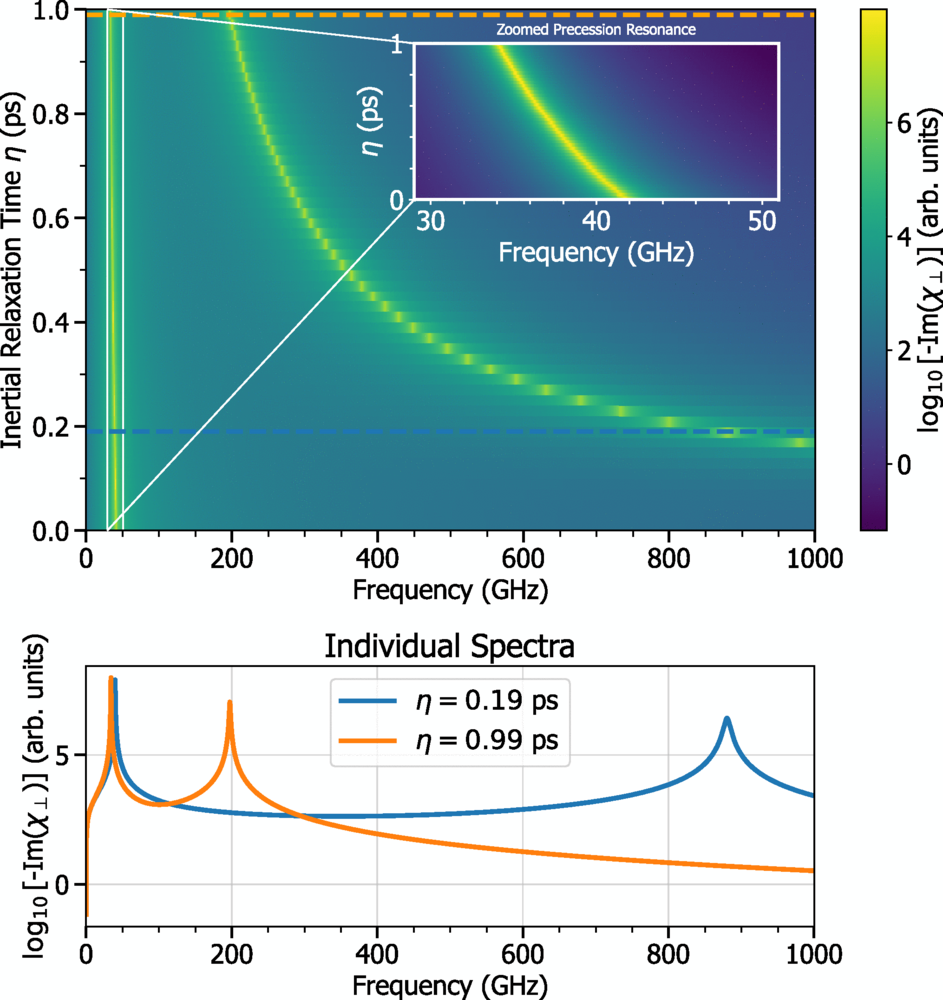
|
Our research group has developed a new theoretical model that offers a deeper understanding of how magnetic materials behave at extremely high frequencies. Published in the APS journal Physical Review B, our work explains how inertial effects influence the magnetic resonance response of ferromagnets.
Previous models for microwave spectroscopy reached their limits when frequencies became so high that the inertia of magnetic moments came into play. This inertia causes the magnetization to show a delayed response to an applied magnetic field, much like a spinning top that wobbles (nutation) after a nudge before settling back into a stable rotation.
The new framework provides a comprehensive mathematical solution to quantitatively predict these effects. It yields the complete tensor of the magnetic susceptibility, a measure of how a material responds to an external magnetic field. Crucially, our model accounts for both the primary oscillation (precession) of the magnetisation and the subtle, high-frequency nutation that occurs in the terahertz range for continuous microwave excitation.
These findings are particularly relevant for magnonics, a field that uses spin waves to transmit and process information. By paving the way for new magnonic components operating in the terahertz range, this research could be the foundation for the next generation of ultra-fast, energy-efficient data processing.
https://doi.org/10.1103/dhk6-78tt
|
|
2025-09-04: New CRC/TRR 270 HoMMage Publication: Nanocrystalline Room-Temperature Ferromagnetic CoCrFeNiGa High-Entropy Alloy with Potential Breakthrough for Spintronic Devices
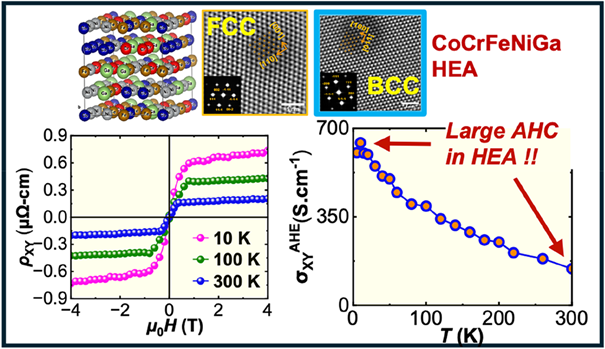
|
We are delighted to announce our recent publication in ACS Nano in collaboration with Prof. Hari Srikanth and his group at the University of South Florida.
In this work, we report on nanocrystalline CoCrFeNiGa, a room-temperature bulk magnetic high-entropy alloy (HEA) based on 3d transition metals. The alloy exhibits mixed BCC–FCC phases with ~51 nm crystallites, a high Curie temperature of ~872 K, soft magnetic behavior, and spin freezing below 60 K.
Most notably, CoCrFeNiGa demonstrates a large intrinsic anomalous Hall effect (AHE) — ~603 S⋅cm-1 at 5 K and ~144 S⋅cm-1 at 300 K — making it highly promising for next-generation spintronic devices.
This study highlights nanocrystalline magnetic HEAs as robust candidates for applications under demanding conditions, opening exciting avenues for spintronic architectures.
For details see here
|
|
2025-08-08: Invited talks at Magnonics 2025 (Spain) and Spintronics XVIII (SPIE Optics + Photonics 2025, USA)
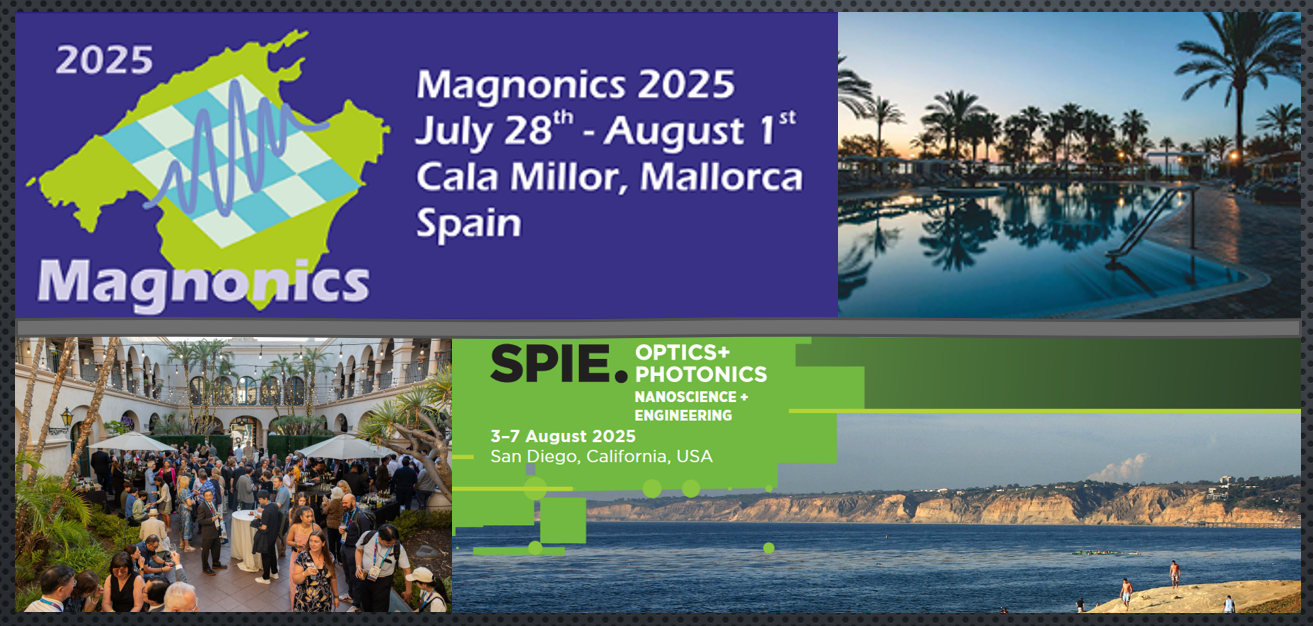
|
Our group members gave invited talks at international conferences Magnonics 2025, Spain (Anna Semisalova) and Spintronics XVIII, SPIE Optics + Photonics, Nanoscience + Engineering Symposium, USA (Jonas Wiemeler). |
|
2025-07-18: New CRC/TRR 270 HoMMage publication: Nanocrystalline CoMnFeNiGa high entropy alloys: Room temperature ferromagnetism bridging the gap from Bulk to Nano
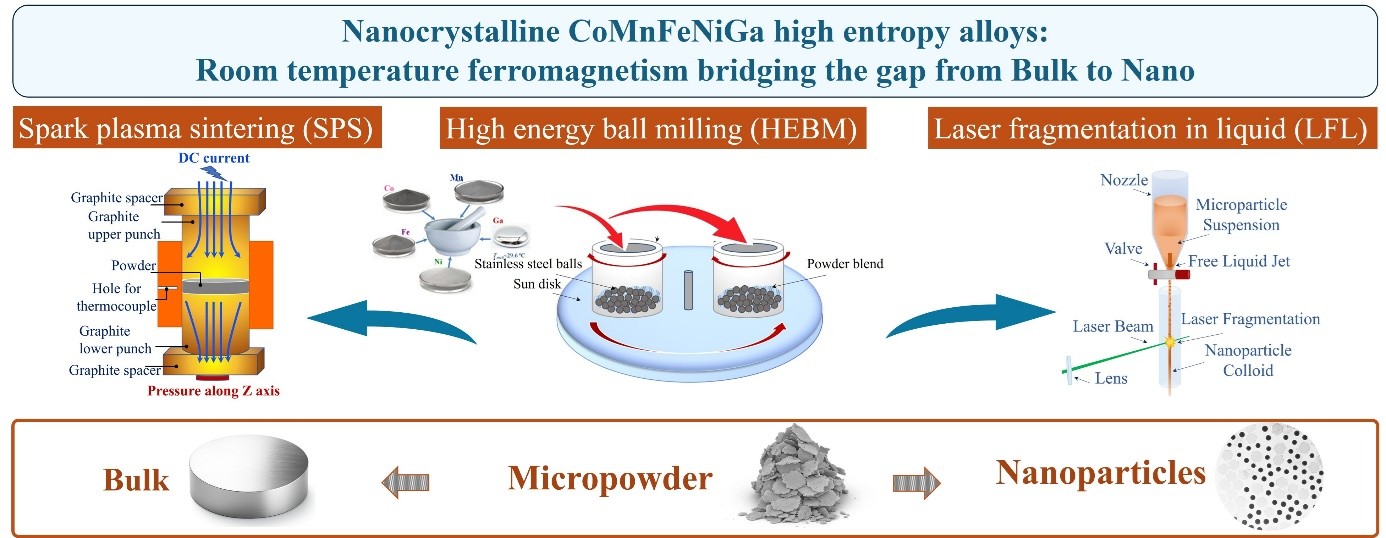
|
This study demonstrates a scalable and unique processing strategy for tailoring the structure, microstructure and magnetic properties of CoMnFeNiGa HEAs across different length scales — micropowder, bulk, and NPs. The high energy ball milling (HEBM) enables the incorporation of low-melting Ga into a stable, single-phase FCC nanocrystalline HEA matrix. Subsequent spark plasma sintering (SPS) induces partial FCC→BCC transformation and nanoscale compositional segregation, producing dual-phase HEA bulk with enhanced magnetic performance. Microparticle laser fragmentation in liquid (MP-LFL) emerges as a robust synthesis platform for producing compositionally complex NPs in a single step directly from the HEBM microparticles. Metal-liquid interactions critically determine the NP morphology (spheres and platelets) and subsequent phase structure, offering promising avenues for solvent-dependent phase control while retaining multi-elemental stoichiometry. Despite structural complexity, all forms exhibit RT ferromagnetism, with magnetic behavior governed by processing-induced variations in phase composition, crystallite size, and microstrain. A rapid thermal treatment (30 s) at 1000 K led to significant improvements in magnetic properties across all forms, driven by phase transformations and microstructural modification. This study provides a new pathway to engineer soft ferromagnetic HEAs with tailored properties by controlling phase composition, crystallite size, nanoscale chemical segregation, and processing-induced microstructure through synthesis and subsequent heat treatment.
For details see here.
|
|
2025-07-01: New publication: Amorphization of laser-fabricated ignoble high-entropy alloy nanoparticles and its impact on surface composition and electrochemistry

|
This study presents a green and scalable approach for synthesizing ignoble high-entropy alloy (HEA) nanoparticles using Laser Synthesis and Processing of Colloids (LSPC) in ethanol, developed through a collaboration within the Transregio CRC/TRR 270 HoMMage. By employing laser ablation in liquids (LAL) with nanosecond and picosecond pulses, phase-selective synthesis of CrMnFeCoNi and CrFeCoNiCu nanoparticles was achieved. The internal structure — amorphous or crystalline — was controlled by pulse duration, with amorphization favored in Cu-containing systems due to enhanced carbon incorporation from laser-induced solvent decomposition.
The underlying mechanism combines thermal kinetics and in situ reaction chemistry. The concept was successfully extended to microparticle laser fragmentation in liquids (MP-LFL), confirming its scalability and effectiveness. Electrochemical analysis showed that surface composition, especially the substitution of Mn with Cu, had a stronger influence on oxygen evolution reaction (OER) performance than structural phase alone. Amorphous CrMnFeCoNi nanoparticles exhibited the highest catalytic activity and durability, demonstrating the potential of LSPC for designing functional HEA nanomaterials through combined structural and compositional tuning.
For details see here.
|
|
2025-06-25: Decomposition of Ni50Mn45In5: A Transmission Electron Microscopy study
 |
In an international collaboration with Prof. Zi-An Li (Guangxi University) and his group we studied the microstructural changes during thermal treatment up to 750 K. Both ex situ and in situ TEM experiments reveal similar trends in the processes of alloy decomposition and nanoprecipitation, But the influence of sample thickness and vacuum conditions during in situ TEM heating must be considered. Additionally, we establish a relationship between the magnetic properties of the dual-phase system, consisting of antiferromagnetic L10–NiMn matrix and ferromagnetic L21–Ni2MnIn nanoprecipitates and the microstructural features. Our findings may provide insights that can be applied to other Ni–Mn-based alloys and potentially to a broader range of materials, offering a framework for understanding alloy decomposition, nanoprecipitation, and their impact on magnetic properties. For details see here.
|
|
2025-06-16: Podcast "Energopolis": Magnete als Klimaretter
In dieser Folge begrüßen wir Prof. Dr. Michael Farle, Leiter der AG Farle – Struktur und Magnetismus nanoskaliger Systeme an der Universität Duisburg-Essen. Prof. Farle erläutert, wie magnetische Materialien in Anwendungen von Windkraftgeneratoren über Elektromobilität bis hin zu magnetokalorischen Kühlsystemen zum Klimaschutz beitragen können. Dabei sprechen wir über Herausforderungen in der Ressourcenschonung, Recycling und Forschungsperspektiven.
Folge #29: Prof. Dr. M. Farle – Magnete als Klimaretter |
2025-06-12: Rare-Earth-free materials: An alternative for current magnetocaloric alloys
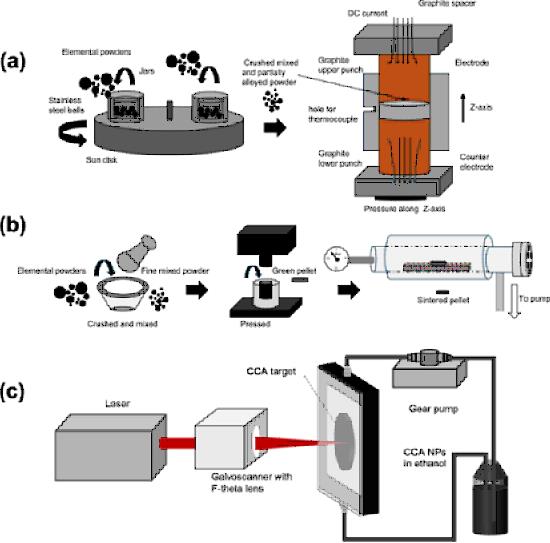
|
In a collaboration within the Transregio TRR270 we prepared and studied rare-earth-free compositionally complex alloys (CCAs) with magnetic phase
transitions, spanning from bulk materials to nanoparticles. Magnetic phase transitions at the Curie temperature are essential for applications like magnetocaloric refrigeration, magnetic sensors, and actuators, but the reliance on costly, scarce rare-earth materials limits sustainability. Specifically, we investigated Mn22.3Fe22.2Ni22.2Ge16.65Si16.65 (Ge-based CCA) and Mn0.5Fe0.5NiSi0.93Al0.07 (Al-based CCA). Magnetization measurements confirm a ferromagnetic-to-paramagnetic phase transition in bulk alloys, with Tc = 179 K for Ge-based CCA and Tc = 263 K for Al-based CCA. At the nanoscale, both Ge- and Al-based NPs exhibit superparamagnetic behaviour, with blocking temperatures of TB ≈ 120 K for Ge-based NPs (xc = 13.4 ± 15.5 nm, average particle size) and TB ≈ 100 K for Al-based NPs (xc = 18.4 ± 9.1 nm, average particle size). Our results indicate that the Al-based CCA is a promising, cost-effective alternative to Ge-based CCA at the nanoscale, providing an economically viable and cost-effective alternative for nanoscale-based applications. Details see here
|
|
2025-05-16: Magnetocrystalline anisotropy of the MAB phase Fe$_2$AlB$_2$
 |
Within the collaborative research center HoMMage (CRC/TRR 270), we determined the temperature dependence of the magnetocrystalline anisotropy of Fe2AlB2 for the first time. Fe2AlB2 belongs to the group of the MAB phases and is a promising candidate for magnetocaloric applications due to low costs and its magnetic transition close to ambient temperature.
See the publication in
Physical Review Materials
.
|
|
2025-05-01: Visit of Prof. Preeti Bhobe
 |
We are happy to announce the visit of Prof. Preeti Bhobe (Indian Institute of Technology Indore, India) within the UDE International Guest Lecturer Programme. She specializes on studying different functional materials using X-ray absorption fine structure (XAFS) spectroscopy and will give three lectures on functional materials like Half-metals and topological states in Heuslers, and Magneto-transport in 2D Chalcogenides and Kagome lattices.
|
|
2025-04-24: Magnetic nanoplatelets for biomedical applications
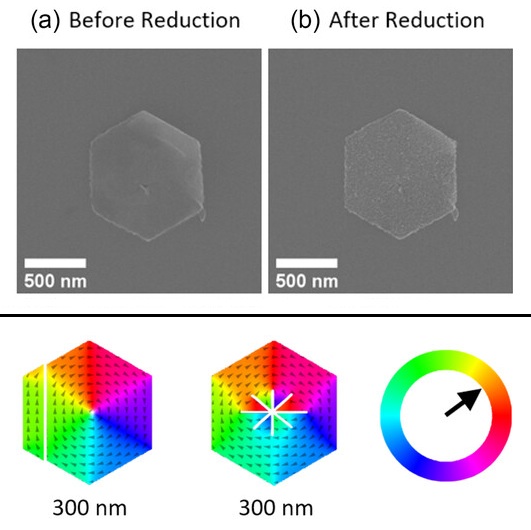 |
Magnetic nanoparticles for diagnostic applications require unique magnetic properties and the ability to be manipulated by external magnetic fields. Our collaborative study presents the synthesis of uniform magnetic CoNi nanoplatelets through the topotactic reduction of metal hydroxides. Different state-of-the-art magnetic measurement techniques confirm the formation of ferromagnetic metal platelets with a magnetic vortex-like structure at ambient temperature. Additionally, micromagnetic simulations confirm the formation of magnetic vortex remanent states at diameters between 200 nm and 1 μm and a thickness of 12 nm. Notably, structural defects and thickness variations do not directly destabilize the magnetic vortex configurations. Details can be found in https://doi.org/10.1002/smsc.202500111.
|
|
2025-04-19: Ways to manipulate magnetism in a high entropy alloy
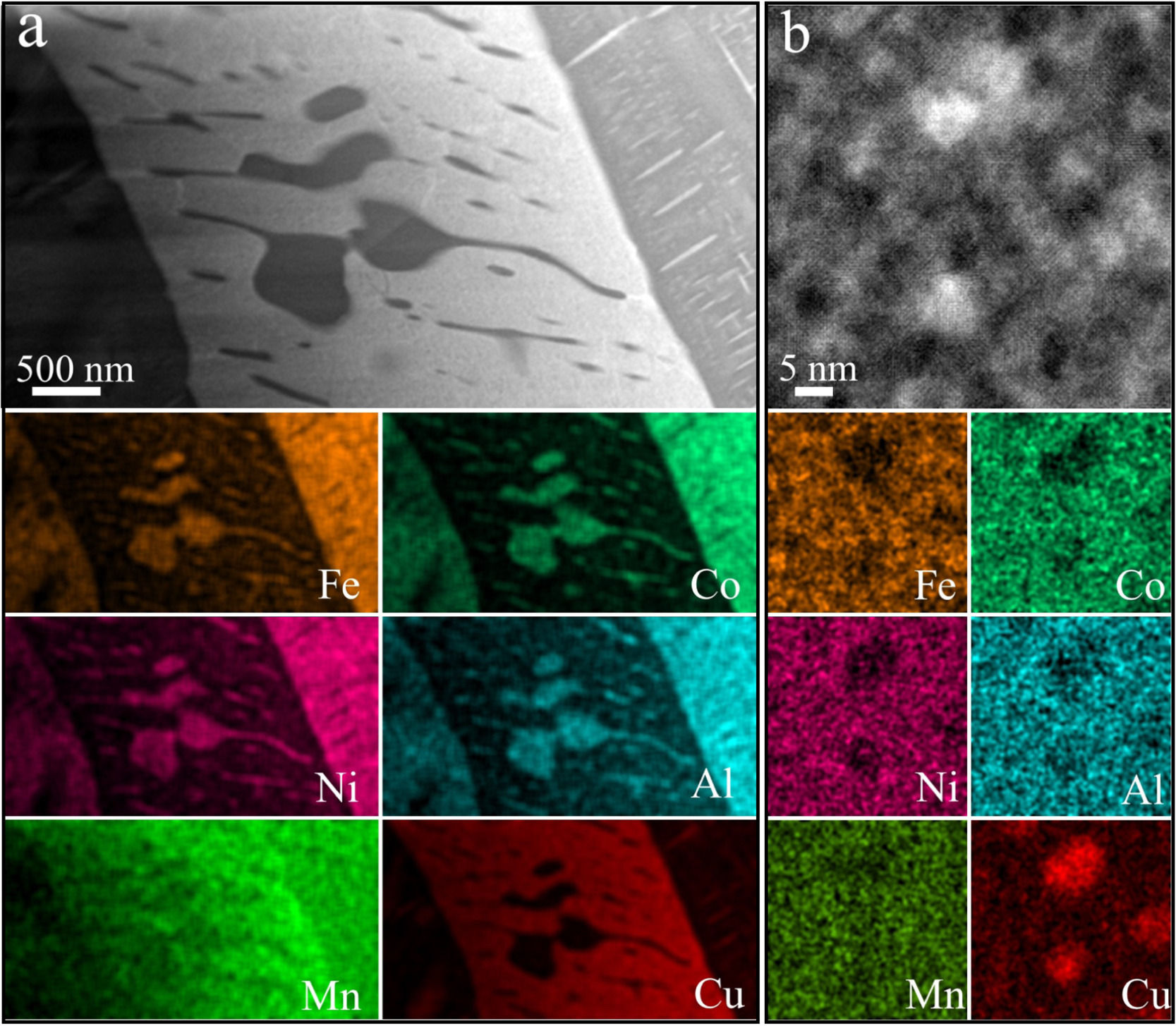 |
In a recent collaboration between the groups of Prof.s Zi-An Li and M. Farle we demonstrate how the microstructure influences the soft magnetic and mechanical properties of (MnFeCoNiCu)100-xAlx, (x = 20, 25, 30, 35, 40). The addition of Al promotes a microstructural change from a coexistence of face-centered cubic (FCC), body-centered tetragonal (BCT), and B2 phases to a single B2 phase. The alloys exhibit high saturation magnetization MS = 105.5 Am2/kg at T = 100 K), low coercivity ( = 8.7 A/m), high Curie temperature ( = 732 K), and high Vickers hardness of 513 HV. Details can be read in https://doi.org/10.1016/j.jmrt.2025.04.061.
|
|
2024-12-10: Research stay of Ye Jiang (Tohoku University) in our group
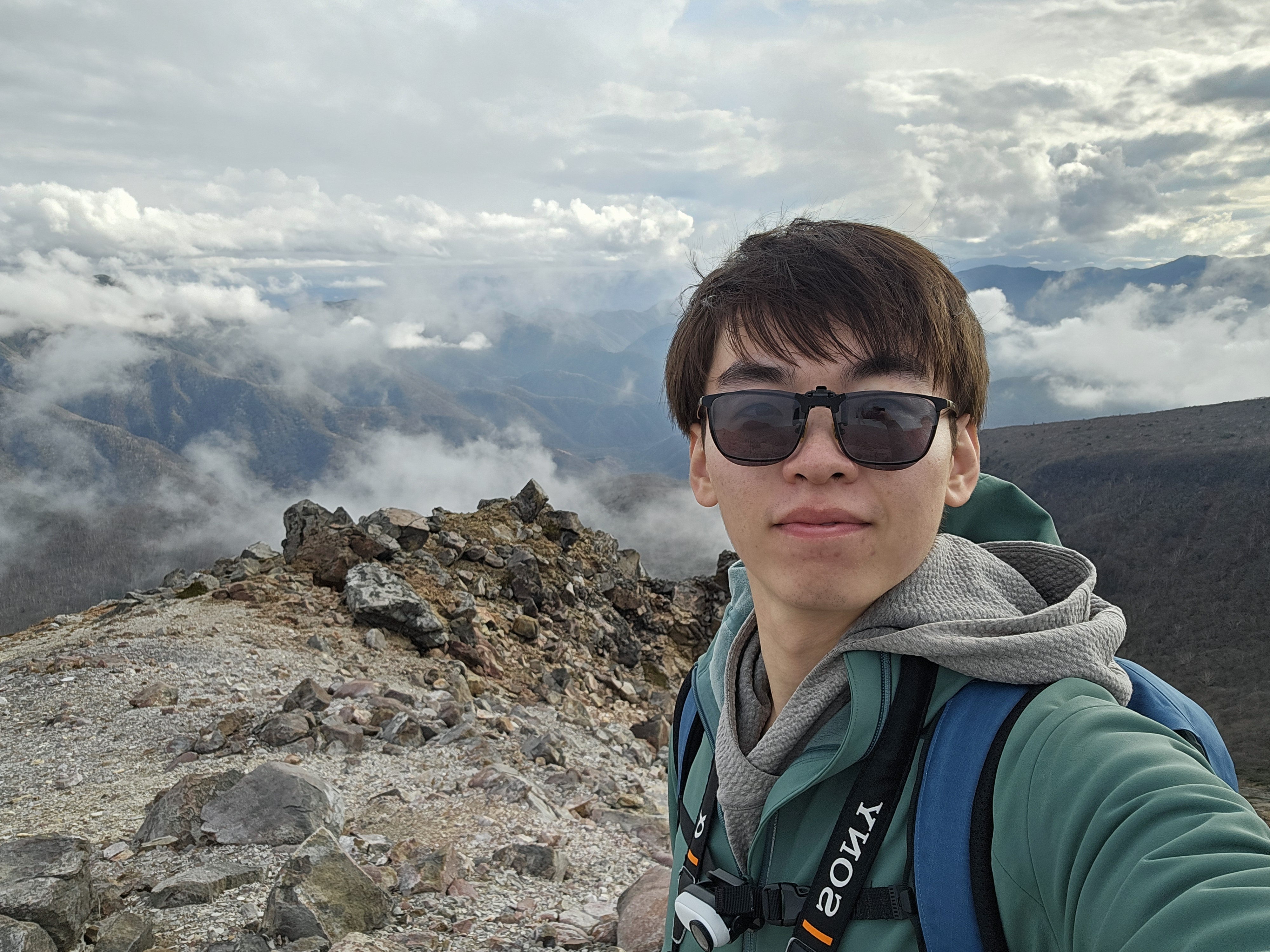 |
We welcome Ye Jiang from the Department of Electrical Engineering, Graduate School of Engineering, Tohoku University in our group! During his 6-months stay Ye will investigate static and dynamic magnetic properties of epitaxial FeSi and FeGe thin films and correlation of damping and magnetostriction.
|
|
2024-12-03: New publication in Acta Materialia
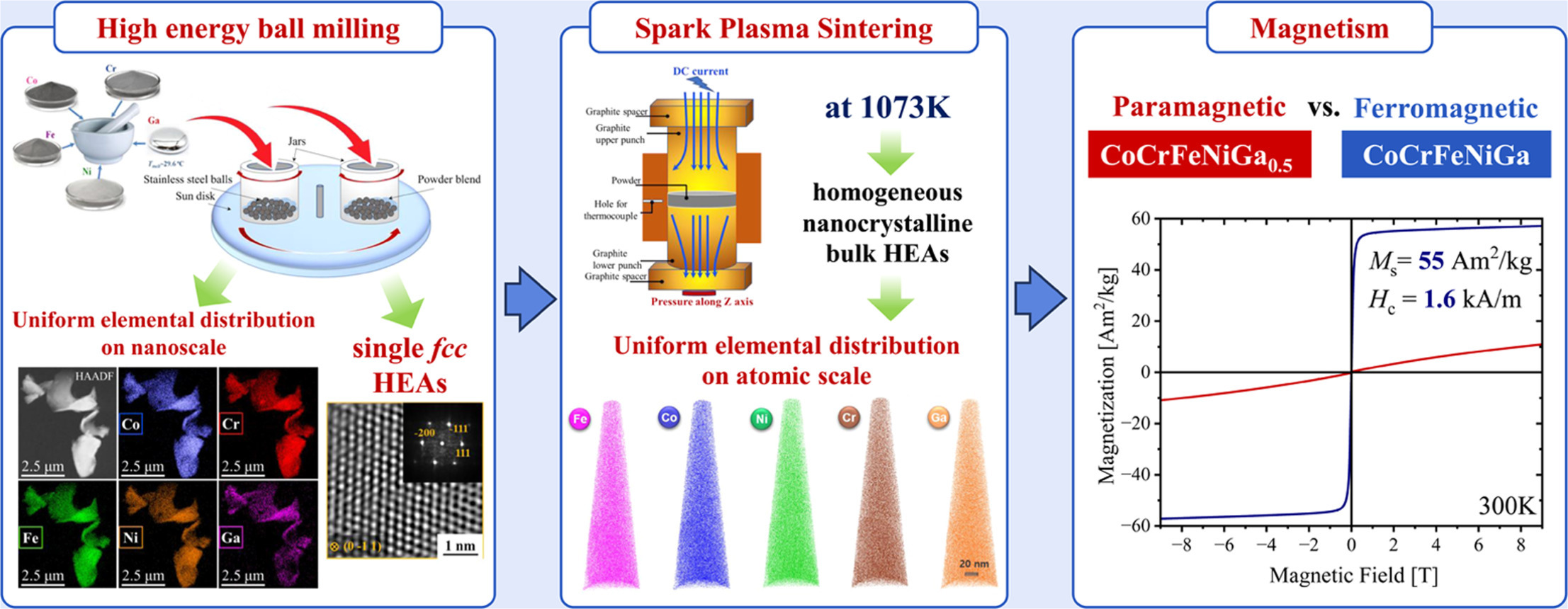
Our recent study has successfully demonstrated the one-step synthesis of homogeneous nanocrystalline (~ 10 nm) single-fcc magnetic CoCrFeNiGax (x = 0.5; 1) high entropy alloy (HEA) powder particles containing low melting element of Ga through short-term high energy ball milling (HEBM). The results of their thermal stability (up to 1300 K ±5 K) in correlation with their structure, composition and enhancement of magnetic properties during heat treatment, as well as after consolidation by spark plasma sintering (SPS) were investigated including high resolution transmission electron microscopy (HRTEM) and atom probe tomography (APT).
The combination of HEBM and SPS yields homogeneous bulk HEAs with low-melting Ga and enhanced structural, composition, and thermal stability, as well as improved magnetic properties, Ms = 55 Am2/kg and Tc = 750 K, which is 45% and 47 K higher, respectively, compared to conventional melting approaches.
The study was carried out in collaboration with the Max Planck Institute for Sustainable Materials (Düsseldorf, Germany) and Ernst Ruska Centre for Microscopy and Spectroscopy with Electrons, Forschungszentrum Jülich, (Jülich Germany).
Effect of high energy ball milling, heat treatment and spark plasma sintering on structure, composition, thermal stability and magnetism in CoCrFeNiGax (x = 0.5; 1) high entropy alloys
N. F. Shkodich, T. Smoliarova, H. Ali, B. Eggert, Z. Rao, M. Spasova, I. Tarasov, H. Wende, K. Ollefs, B. Gault, M. Farle
Acta Materialia 284 (2025), 120569. DOI: https://doi.org/10.1016/j.actamat.2024.120569.
|
2024-12-02: Magnetic hardening of SmCo5: the search for the perfect defect
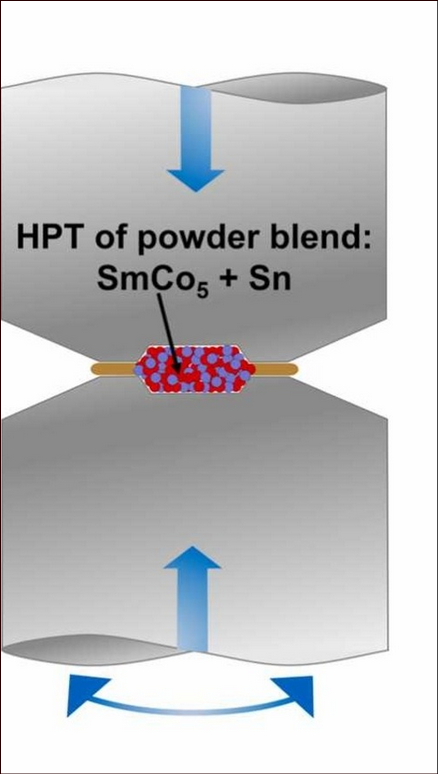 |
The CRC/TRR20 „HoMMAge” investigates new ways to enhance the magnetic energy product of high-performance magnets. In our recent publication Hard magnetic SmCo5-Sn nanocomposites produced by high-pressure torsion we demonstrate how High-Pressure Torsion (HPT) processing of SmCo5 and Sn powder blends produces tailored textures of magnetic SmCo5-20 wt.% Sn nanocomposites. The use of powders as precursors which are consolidated by the process, overcomes the limitations of conventional sintering based routes, as the hard magnetic phase and the grain boundary phase can be freely selected. Simultaneously, the microstructure can be adjusted by different process parameters.
In this work, Sn is used as binder phase to magnetically decouple the SmCo5 particles and thus enhance magnetic hardening effects while simultaneously it is not soluble within the SmCo5 phase, thus preventing or rather delaying mechanical alloying effects. The influence of different number of rotations on the microstructure and the accompanied magnetic properties is discussed in:
https://doi.org/10.1016/j.jallcom.2024.177858.
|
|
2024-10-21: Warum brauchen wir bessere Magnete?
 |
Magnetische Materialien spielen eine wichtig Rolle für energieeffiziente Energieumwandlungen im Energiemix der zukünftigen Technologien, sei es in zukünftigen Kühl- und Klimatisierungskonzepten, sei es in elektrischen Maschinen (Generatoren in Wind- und Wasserkraftanlagen, Elektromotoren in Robotern oder Kraftfahrzeugen) oder auch in der Informationsverarbeitung. Eine Reihe von Vorträgen und Veröffentlichungen gibt aus Sicht des SBF/TRR270 „HoMMAge” auch für Nichtexperten gut verständliche Einblicke in die JETZT notwendigen Forschungsschritte für eine nachhaltige und energieeffiziente Nutzung von Magnettechnologien.
Das Heft kann hier aufgerufen werden.
Als Ergänzung dazu wurde aus dem Inhalt ein 16-minütiger Podcast in englischer Sprache mittels KI erzeugt, der HIER angehört werden kann. |
|
2024-09-20: 820. WE-Heraeus-Seminar
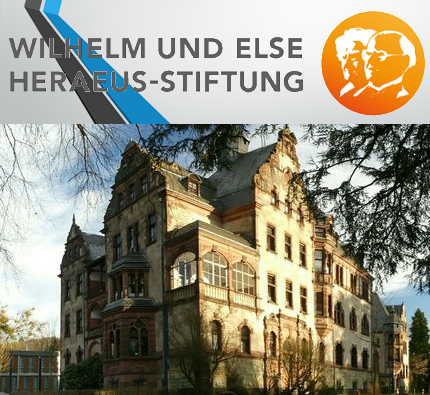 |
The application of Jonas Wiemeler for the participation in 820. WE-Heraeus-Seminar "Hybrid Angular Momentum Transport and Dynamics" has been accepted by the organizers. The seminar will take place on 27-31 October 2024 at the "Physikzentrum Bad Honnef" near Bonn. We are looking forward to Jonas' participation and his impressions on being a part of this renowned seminar. |
|
2024-07-16: Group excursion of AG Farle - summer 2024 edition

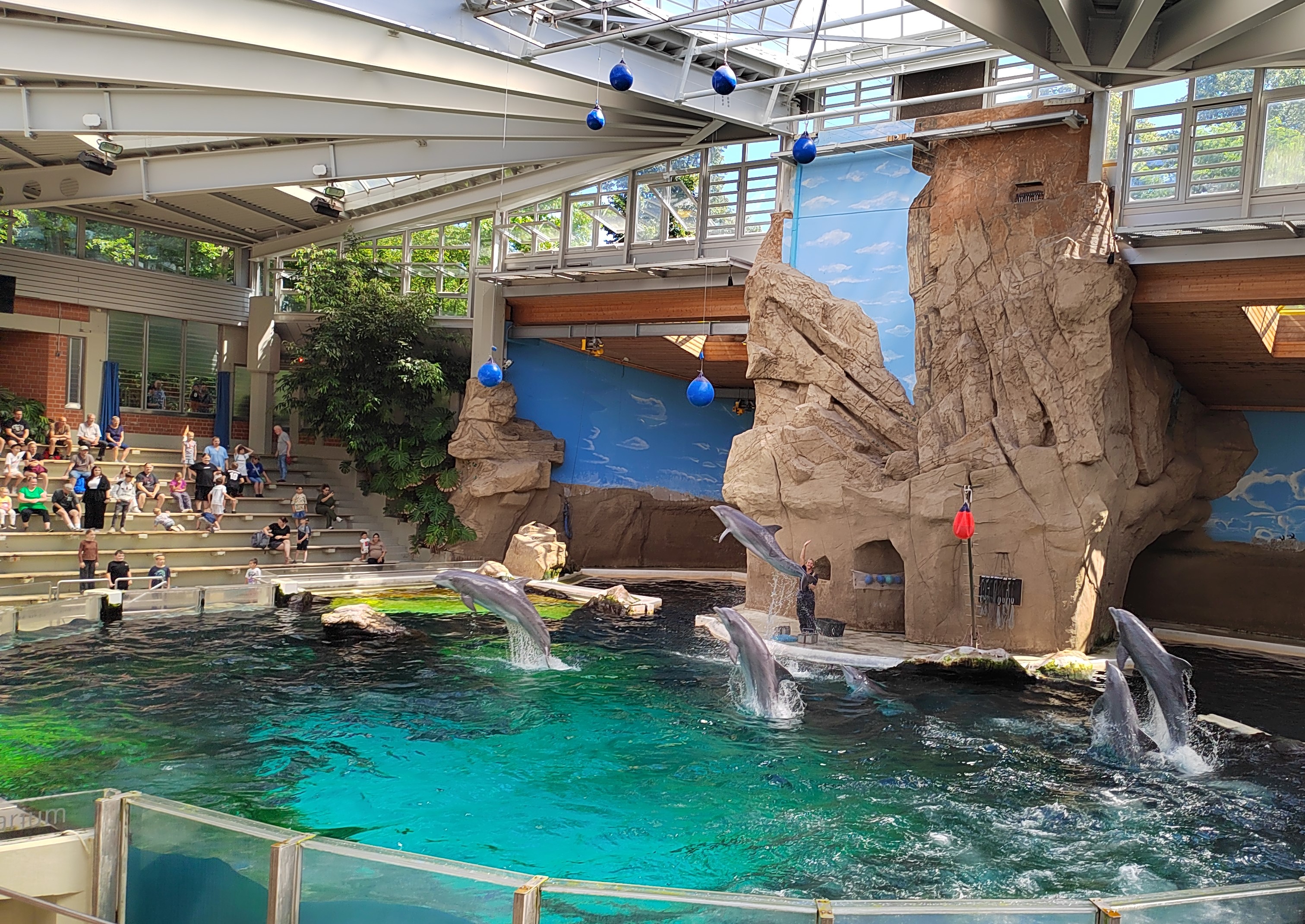 |
We had fun! Our group visited Zoo Duisburg near University. |
|
2024-07-10: Public lecture by Prof. M. Farle in the framework of "Die Kleine Form"
 |
Public lecture "Magnete als Klimaretter (Materialien für eine emissionsfreie Zukunft)" (German only) by Prof. M. Farle in the framework of "Die Kleine Form" on June 19, 2024. The lecture can be seen and heard here: https://www.uni-due.de/kleine-form/farle.php.
|
|
2024-06-16: Congratulations on the excellent PhD defense, Nicolas!
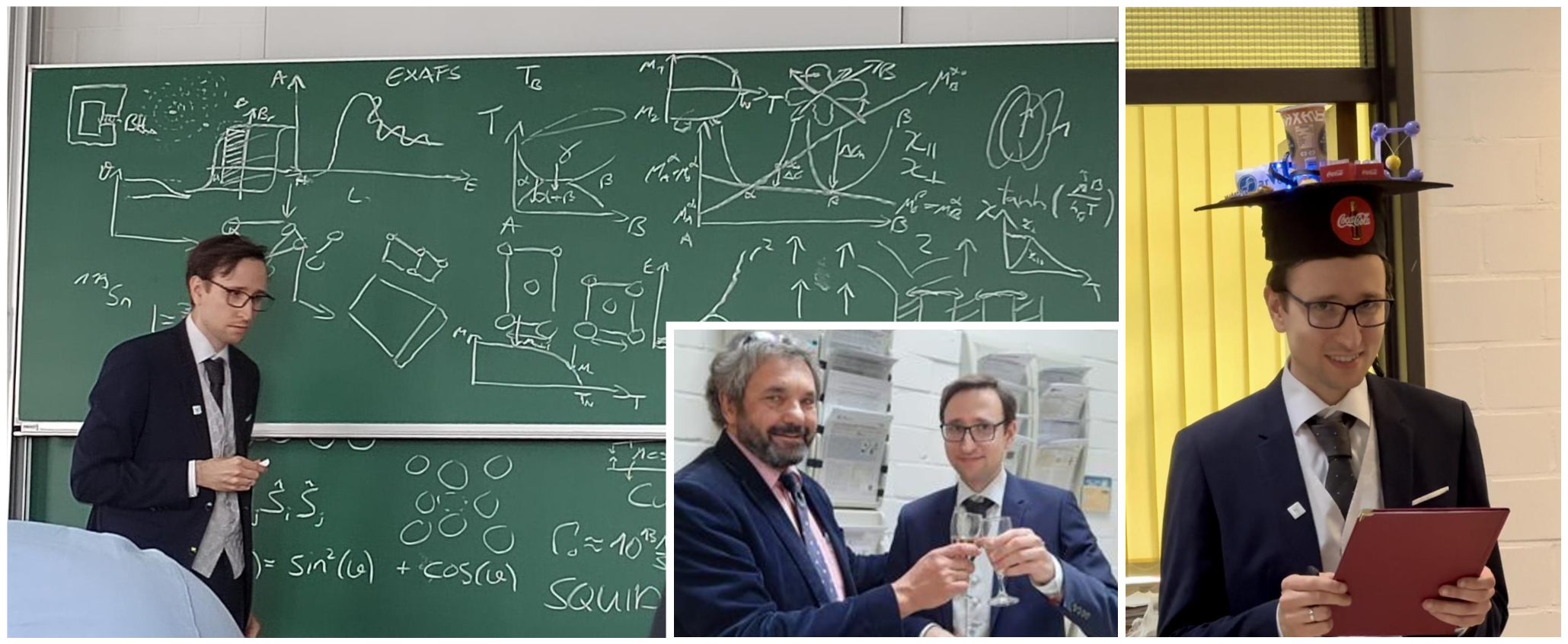 |
We congratulate Nicolas Josten on his excellent PhD defense on June 4, 2024 and the highest grade!
He investigated the cellular decomposition of Ni-Mn-Sn into Ni2MnSn and NiMn. In this material, a magnetic hysteresis curve with a coercive field above 5 T can be obtained by optimizing the annealing parameters. Such materials are useful for efficient energy conversion in generators and electric motors.
Published thesis "Magnetic properties of NiMn, PdMn, and Ni-Mn-Sn after annealing in a magnetic field" is available HERE.
|
|
2024-06-27: Herzlichen Glückwunsch Tim!
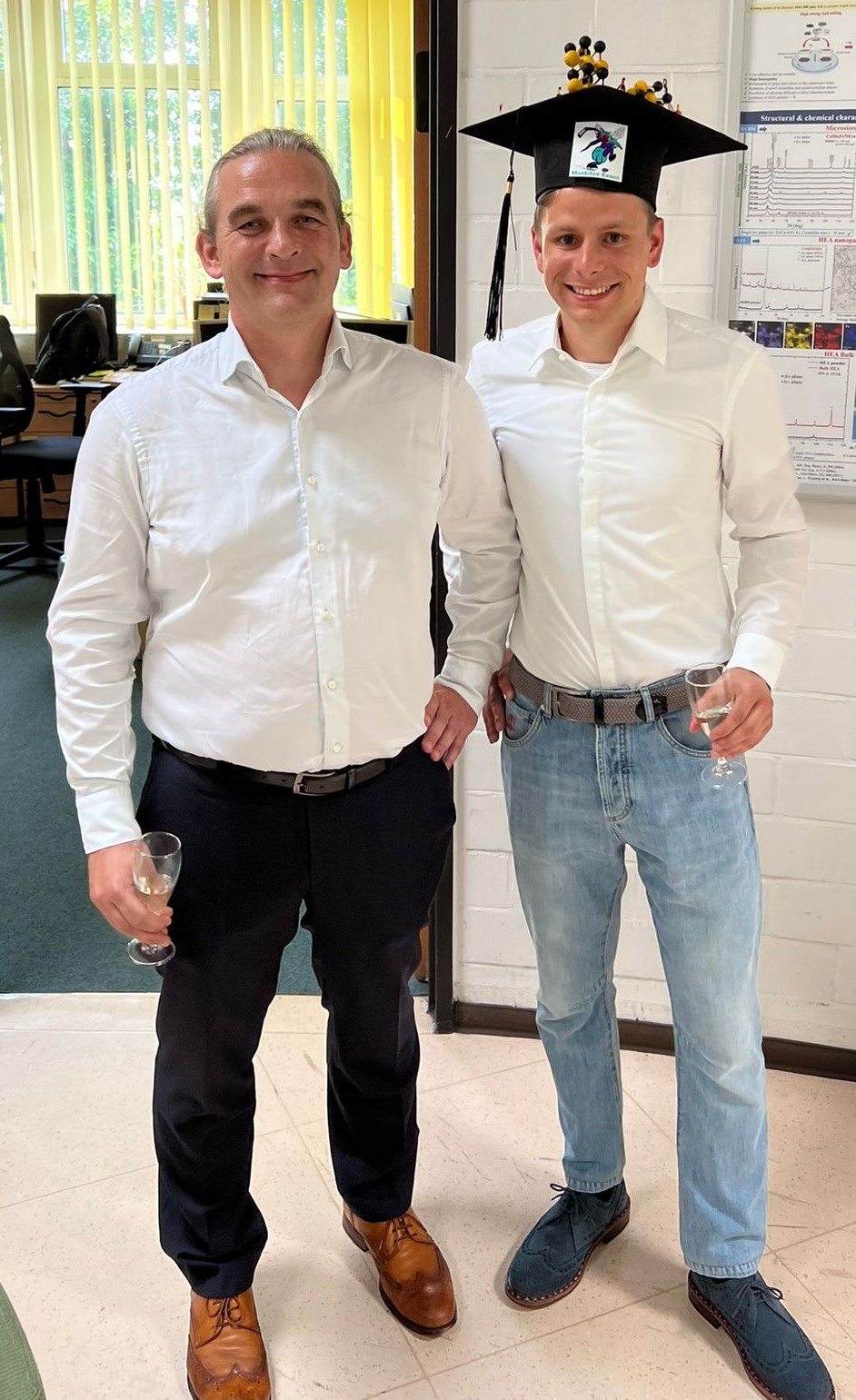
|
Wir gratulieren Tim Salzmann zur erfolgreichen Verteidigung seiner Doktorarbeit! Tim beschäftigte sich in seiner Promotion "Towards ferromagnetic 2D MXenes: Thermal activation of Ti3C2Tx and Fe intercalation in ultrahigh vacuum" mit der Eisen-Diffusion zwischen ultradünne Titancarbid-Blättchen. Tim hat dies unter Ultrahochvakuum-Bedingungen (UHV) bei variablen Temperaturen gründlich untersucht, wobei eine Vielzahl hochmoderner Techniken zur Bestimmung der strukturellen, elektronischen und magnetischen Eigenschaften eingesetzt wurden. Der experimentelle Ansatz erscheint vielversprechend, um ferromagnetische 2D- oder quasi-2D-Materialien mit anpassbarer Wechselwirkung zwischen den durch Diffusion gebildeten ultradünnen magnetischen Schichten zu generieren.
|
|
2024-06-12: Tatiana Smoliarova received UDE Postdoc Seed Funding
Dr. Tatiana Smoliarova's first-time proposal on "3D electron diffraction for high-resolution structural analysis of 2D materials" has been granted by the University of Duisburg-Essen Postdoc Seed Funding. Congratulations!
The funding provides the financial resources for one year and aims to support the successful preparation of an independent application for third-party funding.
The project aims to implement 3D electron diffraction for high-resolution structural analysis of transition metal (TM)-based van der Waals (vdW) Fe, Mn, Ni-cation-mixed phosphorous trisulfides (TMPS3) produced by chemical vapor transport (collaboration with NTU Singapore), which recently received particular attention due to tuneable magnetic properties arising from unpaired magnetic moments from the partially filled d-shells of the TM ions. As a result of the project, the correlation between atomically resolved structure and magnetic response, measured by para-/ferromagnetic resonance, will reveal the precise arrangement of TM ions important for understanding TM ions site preferences, their potential clustering or segregation effects, and the overall stability of the compound. |
2024-06-07: Open position of a lab engineer (the application deadline, July 18th 2024, has passed)
We have an open position (EG 10 TV-L) for a lab Engineer to support the research in our group.
Job Offer (permanent): Lab Engineer, Laboringenieur:in (w/m/d, Nr. 306-24), EG 10 TV-L
Contact: Prof. Michael Farle |
2024-05-24: Epitaxial Fe/Rh bilayers for efficient spin-to-charge conversion

|
We have observed enhanced spin mixing conductance in epitaxial Fe/Rh bilayers and a spin diffusion length of Rh of 9 nm (comparable to Pd), which makes this metallic heterostructure promising for interfacial spin transport. More details on how this new epitaxial system may advance spin-to-charge conversion are available in our paper -
Appl. Phys. Lett. 124, 212404 (2024).
|
|
2024-05-10: Research visit of Prof. Priolkar

|
We are happy to announce the visit of Prof. Kaustubh R.S. Priolkar (School of Physical and Applied Sciences, Goa University, India) within the UDE International Guest Lecturer Programme.
He specializes on studying different functional materials using X-ray absorption fine structure (XAFS) spectroscopy. He is also involved in developing Basic lab course experiments for improving Physics education.
|
|
2024-05-01: We welcome new members of our team
We are glad to welcome two new members of AG Farle group! Niels van de Sand will do Energy Science Ms thesis on Broadband Microwave Spectroscopy of Quasi-2D Materials. Illja Bludov will work on Nanoengineering Bs thesis on magnetron sputter deposition of multifunctional thin films for magnetocalorics and fs-laser processing. |
2024-04-30: Visit of Anna Semisalova to Helmholtz-Zentrum Dresden - Rossendorf
Anna Semisalova has received an invitation to visit the Institute of Ion Beam Physics and Materials Research (HZDR, Dresden - Rossendorf) and to give a seminar talk on April 29, 2024 on application of magnetic resonance spectroscopy for the investigation of novel effects (magnetization nutation) and materials (transition metal mixed van der Waals materials). |
2024-04-26: "Magnete als Klimaretter" UNIKATE 60 Heft erschienen (April 2024)
Magnetische Materialien sind in allen Bereichen unseres täglichen Lebens - vom Kühlschrank, über Elektromotoren und Generatoren bis hin zu Sensoren und Spin basierter Informationsverarbeitung - zu finden. Im Rahmen der Forschungsaktivitäten des CRC/TRR 270 - Hysteresis design of magnetic materials for efficient energy conversion (HoMMage) haben die beteiligten Forscher*innen der Universität Duisburg-Essen eine allgemein verständliche, projektbezogene Beschreibung geliefert, warum Magnete "als Klimaretter" für unsere Zukunft wichtig sind. Das rund 100 Seiten umfassende Heft bietet eine hochaktuelle und unterhaltsame Lektüre und sollte zu weiteren Diskussionen mit Freunden, Familie und Bekannten anregen. Es ist unter folgendem Link als PDF zu erhalten: https://duepublico2.uni-due.de/receive/duepublico_mods_00081818.
Als Ergänzung dazu wurde aus dem Inhalt ein 12-minütiger Podcast in englischer Sprache mittels KI erzeugt, der HIER abgerufen werden kann. |
2024-04-25: New PhD candidate in our group!
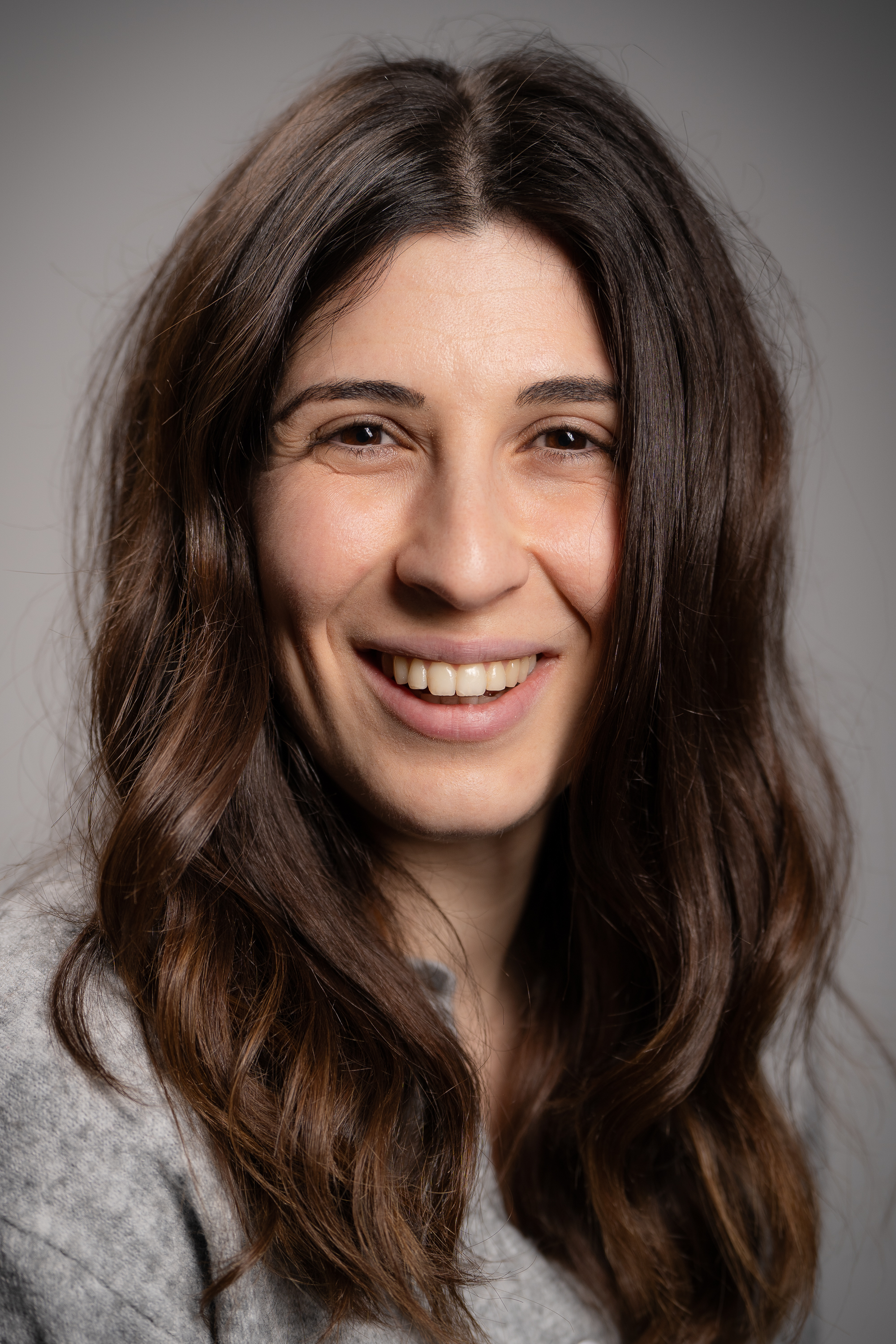
|
We congratulate our colleague Elisavet Papadopoulou to her successful M.Sc. defense. Her thesis has the title "Structure and magnetic properties of novel ferromagnetic CoFeMnNiInx (x=0; 10; 20; 30 at. %) High Entropy Alloys prepared by High Energy Ball Milling".
We are very happy, that she will continue her work as PhD candidate in our group, working under the project A04 "Towards rare earth free permanent magnets by nanoscale phase decomposition" within CRC/TRR 270 HoMMage!
We wish a success in her research and excellent results!
|
|
2024-04-17: Visit of Dr. Natalia Shkodich to the TU Darmstadt
|
Dr. Natalia Shkodich was happy to visit Functional Materials group of Prof. Oliver Gutfleisch at the TU Darmstadt. For three days together with Dr. Franziska Scheibel and Dr. Alex Aubert she synthesized samples using SPS, performed magnetic characterization in the PPMS (14T) and studied phase transitions using DSC. The exchange took place in the framework of the SFB/TRR-270, subproject A04 (PIs Prof. Michael Farle and Dr. Natalia Shkodich) research on shell ferromagnetic materials to tune the magnetic hysteresis by nanoscale selective phase decomposition.
|
|
|
|
2024-03-25: DPG 2024 Berlin: Invited talk on magnetization inertia effects in spin dynamics
Our group actively participated at DPG Spring meeting 2024 in Berlin. Tatiana Smoliarova, Ivan Tarasov, Ulf Wiedwald, Jonas Wiemeler, Elisavet Papadopoulou presented their contributions, Inci Nur Sahin was elected for INNOMAG e.V. Prize 2024 Master Thesis contest. Anna Semisalova gave an invited talk on inertia effects in spin dynamics. Congratulations! |
2024-02-07: Ausschreibung Doktorand*innen oder PostDoc Stelle
Wir haben die Stelle eines wissenschaftlichen Mitarbeitenden TVL 13 ausgeschrieben: https://www.uni-due.de/karriere/stelle.php?kennziffer=086-24 .
Es können sich sowohl Personen, die an einer Promotion interessiert sind, als auch promovierte Personen bewerben, die entweder Ihr eigenes Projekt mitbringen und dieses durch eine(n) weiteren Mitarbeiter*in verstärken wollen, oder selber die PostDoc Position annehmen wollen. Die PostDoc Stelle könnte nach zwei Jahren nach positiver Evaluation um weitere zwei Jahre verlängert werden. |
2024-02-02: We welcome Emmanouil Kasotakis to our team!
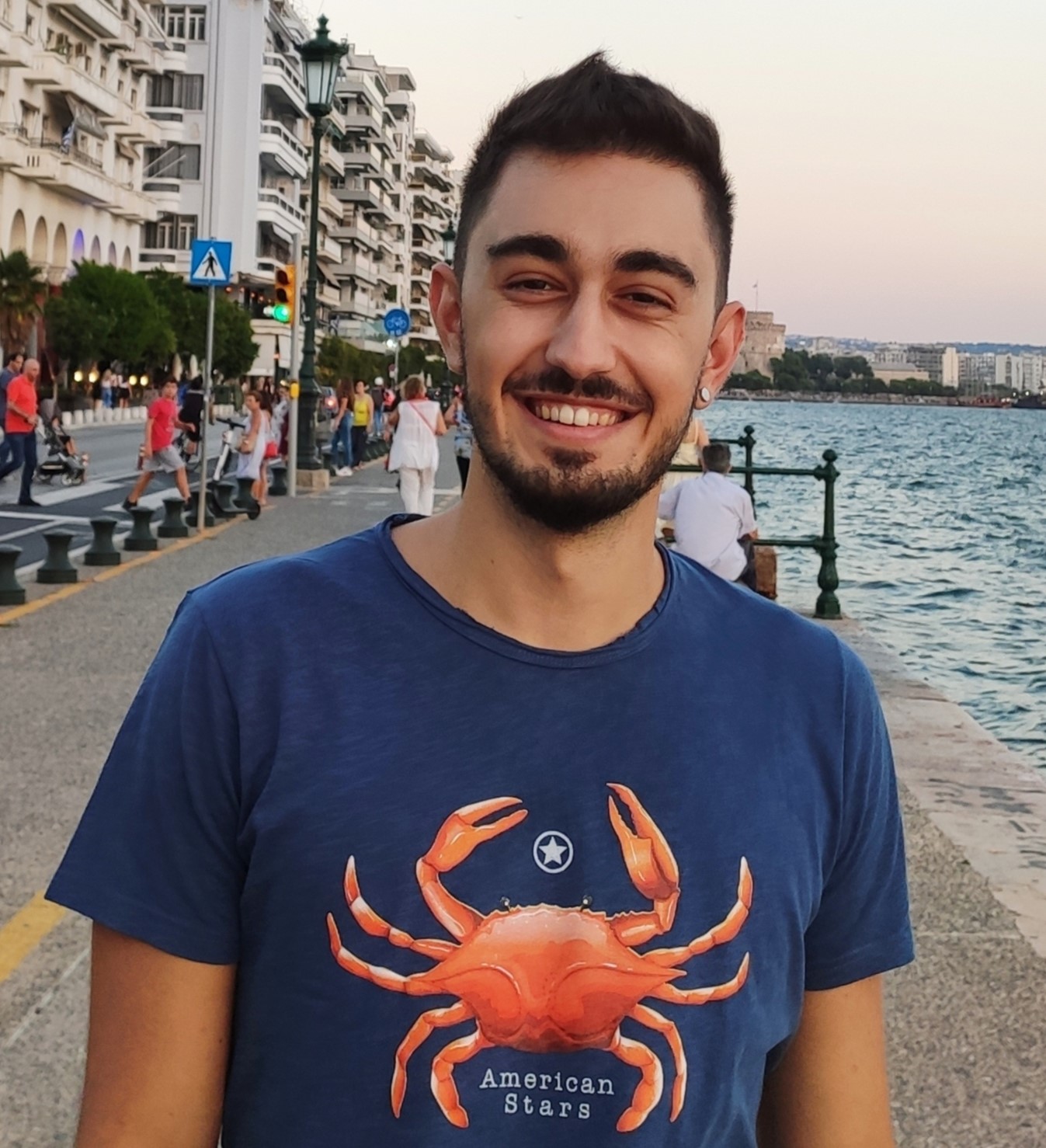
|
He will work on his PhD thesis within the DFG project titled "Tailoring magnetism of High Entropy Alloys (HEA) by high energy ball milling".
His research will be focused on the development of innovative (soft or hard) magnetic HEA materials with chemical and mechanical robustness.
We wish him success in his research and excellent results!
|
|
2024-01-18: "Cellular precipitation in Ni-Mn-Sn revealed", Phys. Rev. Materials 7 (2023) 124411
"Cellular precipitation in Ni-Mn-Sn revealed", Phys. Rev. Materials 7 (2023) 124411
Combining the expertise of 5 participating projects in the SFB/TRR 270 HoMMage the location and morphology of ferromagnetic precipitates in Ni-Mn-Sn was determined. Ni50Mn45Sn05 heated above 600 K decomposes into ferromagnetic Ni2MnSn precipitates in an antiferromagnetic NiMn matrix. If an external magnetic field is applied during annealing, magnetic hysteresis curves with high coercive fields of up to 5 T can be achieved. The origin of this hysteresis has been attributed to the coupling of the antiferromagnetic matrix L10 NiMn with ferromagnetic precipitates (Sn enriched regions), whose location and morphology were not known. To close this knowledge gap, a range of sophisticated experimental techniques – ranging from magnetic force microscopy over transmission electron microscopy to atom probe tomography -was applied aside from conventional magnetometry and x-ray diffraction. The decomposition type is identified as a cellular precipitation starting at grain boundaries and growing into the grains. This leads to a multilayer thin film like lamellar structure with a lamella thickness in the nm range as seen in the attached figure. These results may provide a basis for understanding the magnetic interactions, which lead to the magnetic hysteresis with ultra high coercivity in these types of "shell ferromagnets"
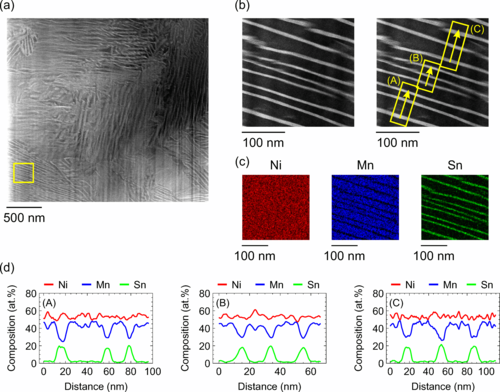
Abb: a) HAADF STEM image of the sample annealed for 24 h at 700 K. The decomposition product of phase I toward Ni2MnSn and NiMn is visible and forms a lamellar structure.
(b) HAADF STEM image of the region marked in (a) (yellow rectangle). The thickness of the Ni2MnSn lamellar precipitates is around 10 nm.
(c) EDX mappings of Ni, Mn, and Sn performed on the area shown in (b).
(d) EDX linescans measured within the yellow rectangles shown in (b). The x-axes of the plots of the linescans follow the yellow arrows. |
2023-08-17: GRATULATION: MSc. Nanoeng. Inci Nur Sahin
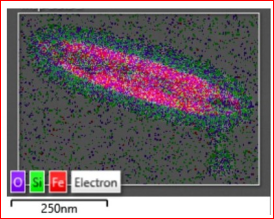
Die Abbildung zeigt die chemische Zusammensetzung eines typischen Partikels. | Wir freuen uns mit Inci über den Abschluss Ihrer Masterarbeit im Studiengang Nanoengineering.
Ihre Arbeit und ihr Abschlusskolloquium wurden mit den jeweils bestmöglichen Noten bewertet.
Ihre Forschung zu "Optimierter Hyperthermie Ansatz mittels Fe3O4/SiO2/Ni Multischalen Nanoellipsoiden"
demonstriert eine neues Konzept zur biomedizinischen Theranostik mit synthetischen Antiferromagneten,
die aus Magnetit Halbschalen in einer Siliziumdioxid Hülle bestehen, naßchemisch herstellbar und hoch-skalierbar sind,
sowie ohne magnetische Streufelder in biomedizinischen Anwendungen verwendet werden könnten.
Die Arbeit ist hier zu finden.
|
|
2023-08-12: Pinned magnetic moments in the collinear antiferromagnet PdMn

|
Pinned magnetic moments in the collinear antiferromagnet PdMn
In a joint research work within the CRC/TRR270 "Hysteresis design of magnetic materials for efficient energy conversion" Nicolas Josten (PhD candidate) in project A04 could show that annealing the collinear antiferromagnet PdMn with excess Pd in a magnetic field produces strongly pinned magnetic moments in the annealing field direction. This behavior can be understood with the help of the magnetic-field-biased diffusion model. Here, the magnetic field creates an energy difference between the two possible occupations of the antiferromagnetic Mn-sublattices by the Pd-excess atoms. This, mediated by diffusion, leads to an imbalance in the amount of the Pd-excess atoms in these sublattices and, subsequently, to an imbalance in the total magnetization of the sublattices. For Details see: Annealing time, temperature, and field dependence of pinned magnetic moments in the collinear antiferromagnet PdMn
|
|
2023-08-09: Helical magnetic structure of epitaxial films of nano-laminated Mn2GaC MAX phase
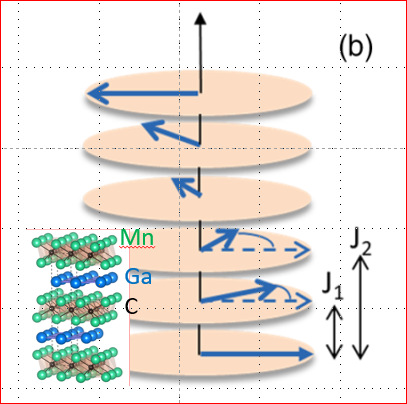
|
In a multinational collaboration we could identify a complex magnetic arrangement of Mn magnetic moments, that is a helical magnetic structure consisting of the ferromagnetically coupled Mn-C-Mn slabs that are twisted across the Ga layer by 167.2 deg with respect to the next Mn-C-Mn slab. As a result, the magnetic structure presents a spiral propagating along the out-of-plane direction (hexagonal c axis) with a pitch of around 14 lattice constants. For Details see: Annealing time, temperature, and field dependence of pinned magnetic moments in the collinear antiferromagnet PdMn
|
|
2023-08-01: Bachelor Thesis: Magnetic Resonance Spectroscopy of (Fe,Mn,Ni)PS3 van der Waals single crystals
Wir begrüßen Moritz Küster in unserem Team. Er forscht seit Juli im Rahmen seine Bachelorarbeit am Verständnis der magnetischen Wechselwirkungen in quasi-2D van der Waals Materialien. Mittels Elektronenspinresonanz als Funktion von Temperatur und Winkel versucht er die intrinsischen magnetischen Phasenübergänge zu identifizieren. Die ersten überraschenden Ergebnisse liegen vor. |
2023-09-07: WIR GRATULIEREN !
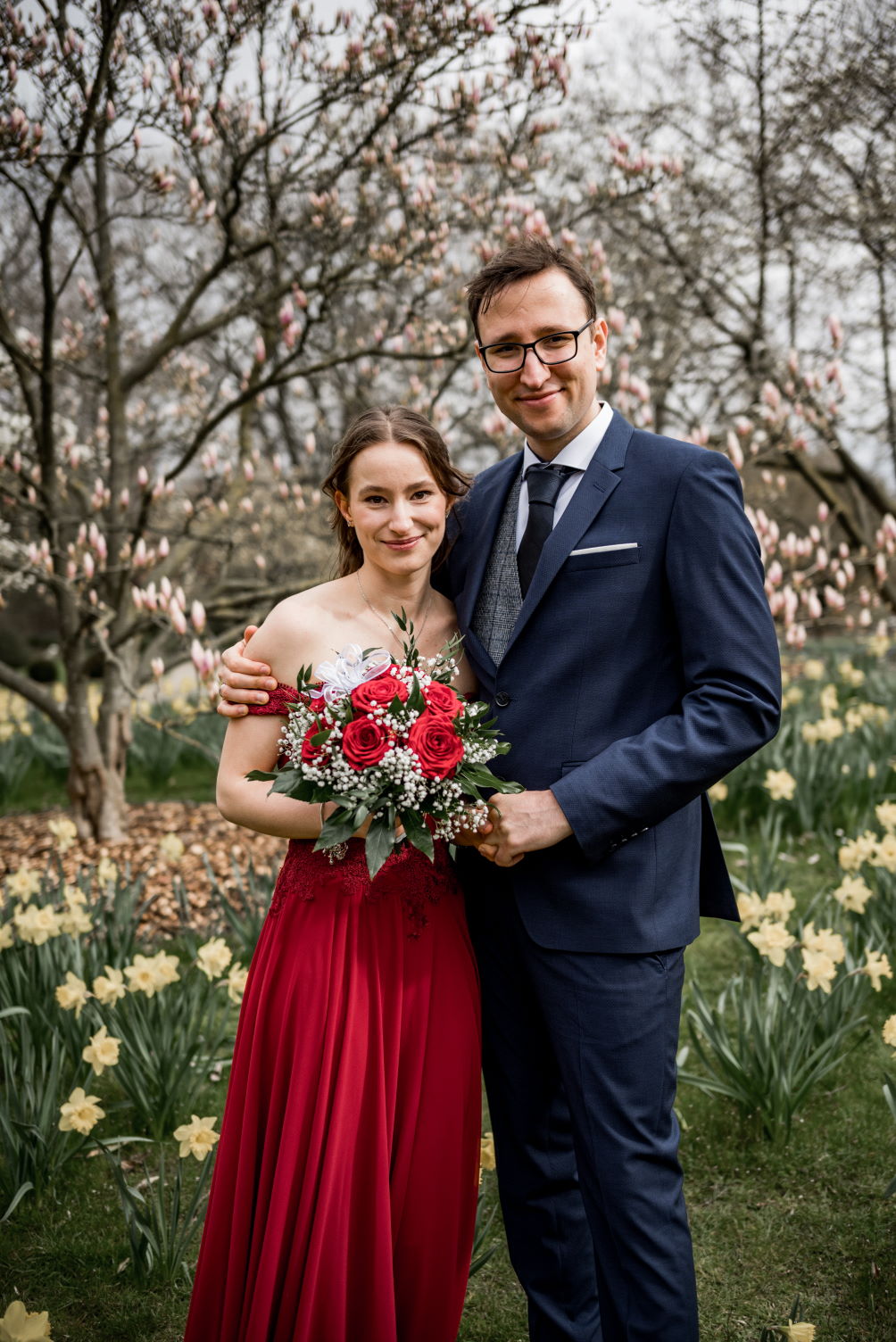
|
Nicolas Josten ist am 22.07.2023 kirchlich getraut worden.
Wir freuen uns mit Ihm und seiner Frau und wünschen beiden alles Gute !
|
|
2023-07-18: Femtosecond Laser Ablation-Induced Magnetic Phase Transformations in FeRh
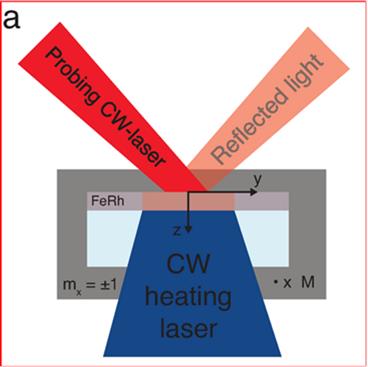
|
In a trilateral French-Spanish-German collaboration we investigated the ablation properties of FeRh films. We found that the initial FeRh film displayed a reversible antiferromagnet-ferromagnet phase transition and the laser-ablated structures exhibited irreversible changes in their magnetic properties. Fluence-resolved measurements clearly demonstrate that the ablation threshold coincides with the threshold of the antiferromagnet-to-ferromagnet phase transition. For details see: Femtosecond Laser Ablation-Induced Magnetic Phase Transformations in FeRh Thin Films .
|
|
2023-07-18: Easy up-scalable synthesis for ferrite nanoparticles
|
2023-08-18: Impressionen der erfolgreichen Begehung zur 2. Förderperiode des SFB/TRR270
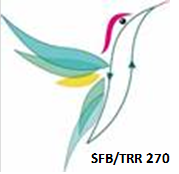 | Hier geht es zur Website. |
|
2023-06-29: Ni-Mn-Sn Heusler alloys manufactured by e-beam and laser powder bed fusion
 | In a recent joint publication of the CRC/TRR270 we published a comparative study of additive manufacture Ni-Mn-Sn Heusler alloys.
Using an uncommon PBF-EB/M spot melting strategy, for the first time, crack-free Ni-Mn-Sn bulk material were produced and the chemical, microstructural, and magnetic properties were analyzed. Results on the magnetocaloric effect of the consolidated samples are reported. For details see S.-K. Rittinghaus et al. , Additive Manufacturing Letters 7 (2023) 100159 . |
|
2023-06-16: Good Bye Manolis!
After his 5-months ERASMUS-funded internship Emmanouil Kasotakis left us after setting up and testing a now fully functioning sputter deposition system which he commissioned together with Moritz Vanselow and Dr. Anna Semisalova.
We wish him a fruitful and successful career wherever his interest my lead him.
|
2023-06-13: Towards THz Physics with GHz excitation (inertia in spin dynamics)
The dynamics of magnetic moments consists of a precession around the magnetic field direction and a
relaxation towards the field to minimize the energy. While the magnetic moment and the angular momentum are conventionally assumed to be parallel to each other, at ultrafast time scales their directions become separated due to inertial effects. The inertial dynamics gives rise to additional high-frequency modes in the excitation spectrum of magnetic materials. Here, our international collaboration reviews the recent theoretical and experimental advances in this emerging topic and discuss the open challenges and opportunities in
the detection and the potential applications of inertial spin dynamics.
For further details see https://doi.org/10.1016/j.jmmm.2023.170830. |
2023-05-02: We welcome Berna Gündogdu Gültepe!
 | She completed her master degree at Istanbul University and is now a visiting researcher at the AG Farle team to develop a project until 31 October 2023.
Focusing on Heusler alloys, the project includes the preparation and examination of multilayer thin films prepared by flash evaporation of multi-element materials. |
|
2023-04-14: Welcome to Elisavet Papadopoulou
 | We welcome Elisavet Papadopoulou to our team, who will work on her Master thesis in NanoEngineering. With the help of Dr. Natalia Shkodich, she will focus on the synthesis of novel room temperature CoMnFeNiIn high entropy alloys by High energy ball milling and study their structural, chemical and magnetic properties.
We wish a success in her research and excellent results! |
|
2023-03-30: We welcome Emmanouil Kasotakis (Aristotle University of Thessaloniki) to our team
 | Within his 5-months ERASMUS-funded internship Emmanouil will learn the basics of vacuum techniques and magnetron sputtering. He will work on deposition of Fe-based ferromagnetic alloys for magnetocaloric and permanent magnet applications. We wish him fruitful and successful stay in our team! |
|
2023-03-29: New publication in "Nano-Structures & Nano-Objects": https://authors.elsevier.com/c/1goto,rVMJnm~Z2444
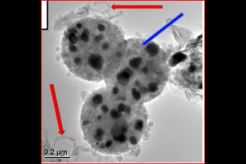 | In our trilateral Armenian, German, Greek project "MaNaCa" we discovered an interesting magnetic composite:Carbon-encapsulated iron-cementite (Fe/Fe3C) magnetic nanoparticles were synthesized by an upscalable solid-state pyrolysis method using iron phthalocyanine as a precursor. The dependence of the structure, morphology and magnetic properties on the pyrolysis conditions is presented. Thenanocomposite contains nanoparticles made of cementite with a small fraction of iron, with an averagediameter of 15 nm embedded in an amorphous carbon matrix.A 3 nm thick graphite shell is formed on the surface of the particles. The volume fraction of α-Feincreases almost linearly on increasing pyrolysis temperature: from 0.5% for the sample synthesizedat 800°C up to 11% for a 900°C pyrolysis temperature, resulting in an increase of the saturationmagnetization from 14.0 to 17.74 Am2/kg and a decrease of the coercivity from 49.34 to 10.74 kA/m |
|
2022-11-07: We welcome Aydan Akyildiz from Gebze Technical University (Turkey)
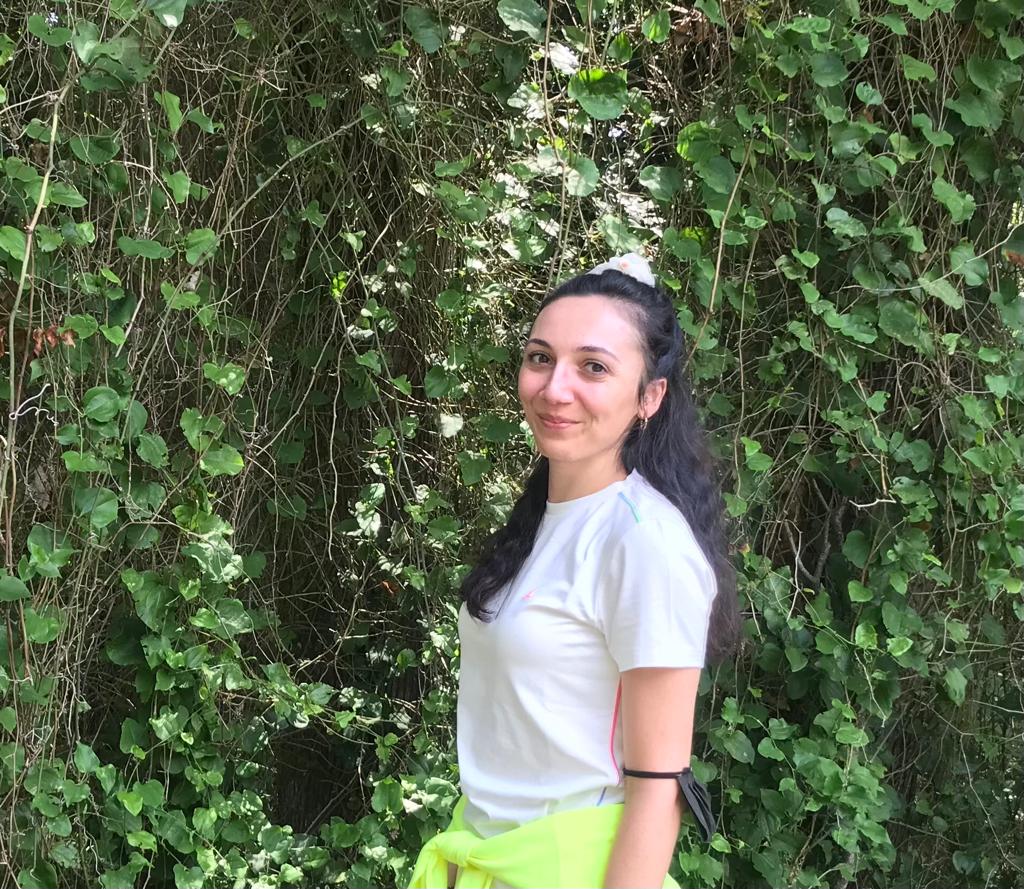 | Aydan will work on her master thesis in our group till February 28, 2023. She studied Physics Engineering at Istanbul Technical University. Her Master thesis will be centered around the magnetic, morphological and structural characterization of Cementite nanoparticles. |
|
2022-10-16: New Publication on a high entropy alloy soft magnet
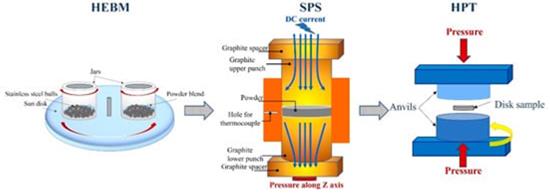 | Soft magnets - that is magnets with a low coercivity - find many applications in sensorics and automobile industry for example. Here a mechanical and environmental robustness is of extreme importance - properties which high entropy alloys provide. Magnetism in such alloys has become a major focus of research in HEAs. In our recent publication we show how to tune magnetic properties in nanocrystalline CoCrFeNiGax (x = 0.5, 1.0) High Entropy Alloys by mechanical treatment. |
|
2022-08-26: New Publication of effects of inertia in the precession of the magnetization
 | High-frequency (THz) excitation of magnetization precession is considered as a new promising route for low energy and ultrafast information processing in next-generation devices. These concepts based on magnon propagation are based on conservative concepts taking the Landau-Lifschitz- Equation into account. In our publication we show that conventional GHz precession of long wavelength magnons is accompanied by additional higher frequency excitations approaching the THz range. This effect is based on the re-discovery that inertia effects in magnetization dynamics are present. |
|
2022-06-20: "MaNaCa": highlighted by video on YOU Tube
Unser EU Project "MaNaCa": Magnetic Nanohybrids for Cancer Therapy is highlighted by an informational video on YOU Tube. https://youtu.be/hcDZRhRTgWg
|
2022-05-09: Humboldt Research Award 2022 (Prof. H. Srikanth)
From South Florida to Duisburg-Essen, AgFarle
Professor Hari Srikanth is a winner of the Humboldt Research Award 2022. As an internationally acclaimed researcher in the field of magnetism and magnetic materials and especially in nanomagnetism, he pioneered the method of radio frequency transverse susceptibility for precise measurements of magnetization dynamics. His current interests focus on exploring novel interfaces in core-shell nanoparticles and thin film heterostructures with the goal to improve our understanding of exchange coupling, proximity effects and thermal spin transport in these systems. In Germany, Professor Srikanth will continue his experimental studies probing interface magnetism in nanostructures and heterostructures, which is of importance for the development of energy saving information processing and biomedical diagnosis and therapy.
Professor Srikanth is hosted by Professor Michael Farle at the University of Duisburg Essen. |
2022-03-28: Welcome to Moritz Sünner and Moritz Vanselow
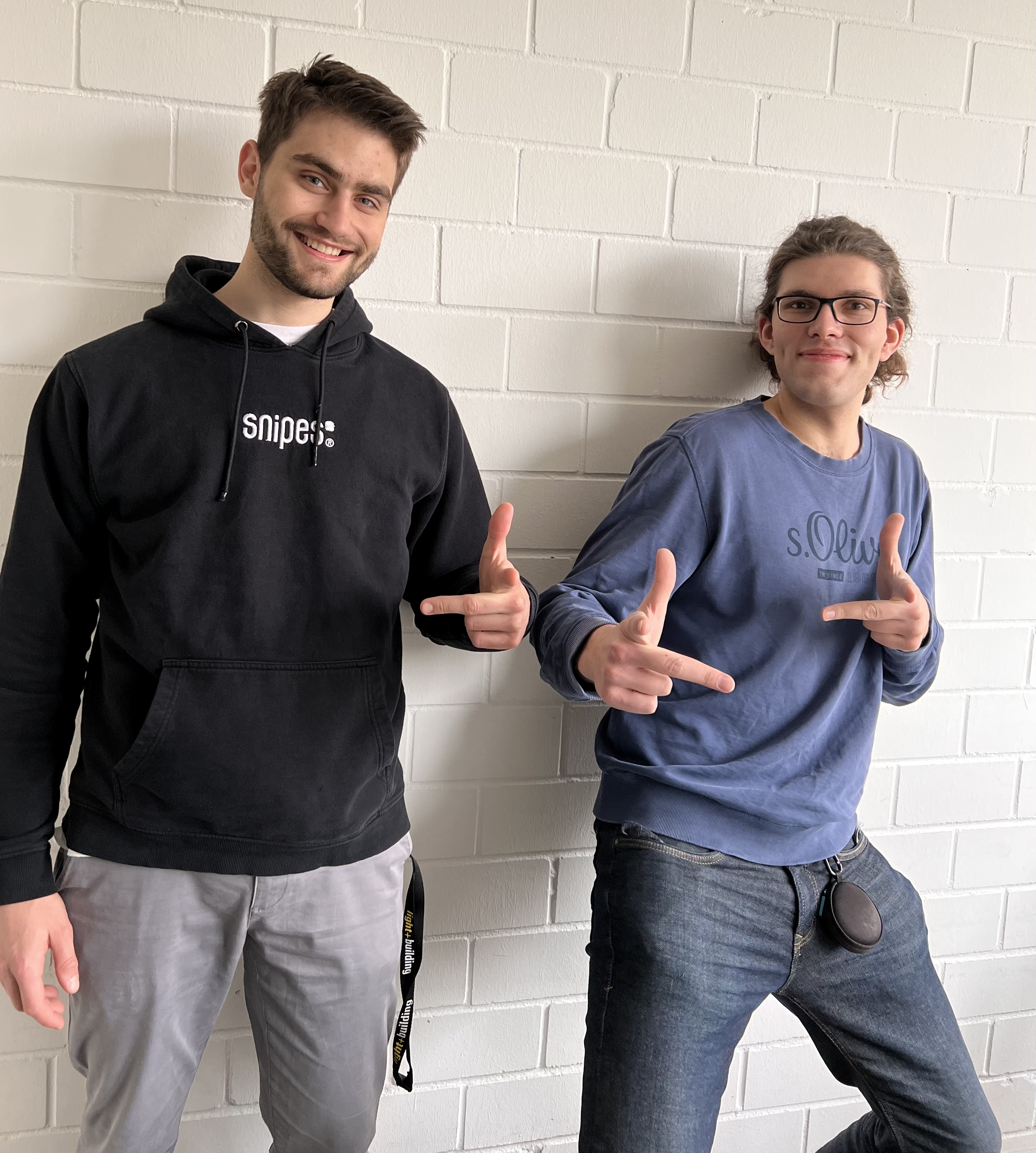 | Moritz Sünner and Moritz Vanselow joined our team to work on their Bachelor Thesis in Energy Science and Physics, respectively. Moritz S. will study the correlation of microstructure and magnetic properties in high entropy alloys prepared by high energy ball milling (Project S01 in the SFB/TRR 270) , and Moritz V. will investigate magnetic resonance phenomena in Heusler compounds (Project A04 in the SFB/TRR 270) with special emphasis on identifying the intrinsic mechanisms to enhance the coercive field.
WELCOME to our team and SUCCESS to your research! |
|
2021-11-25: Welcome to Assoc. Prof. Dr. Asli Cakir
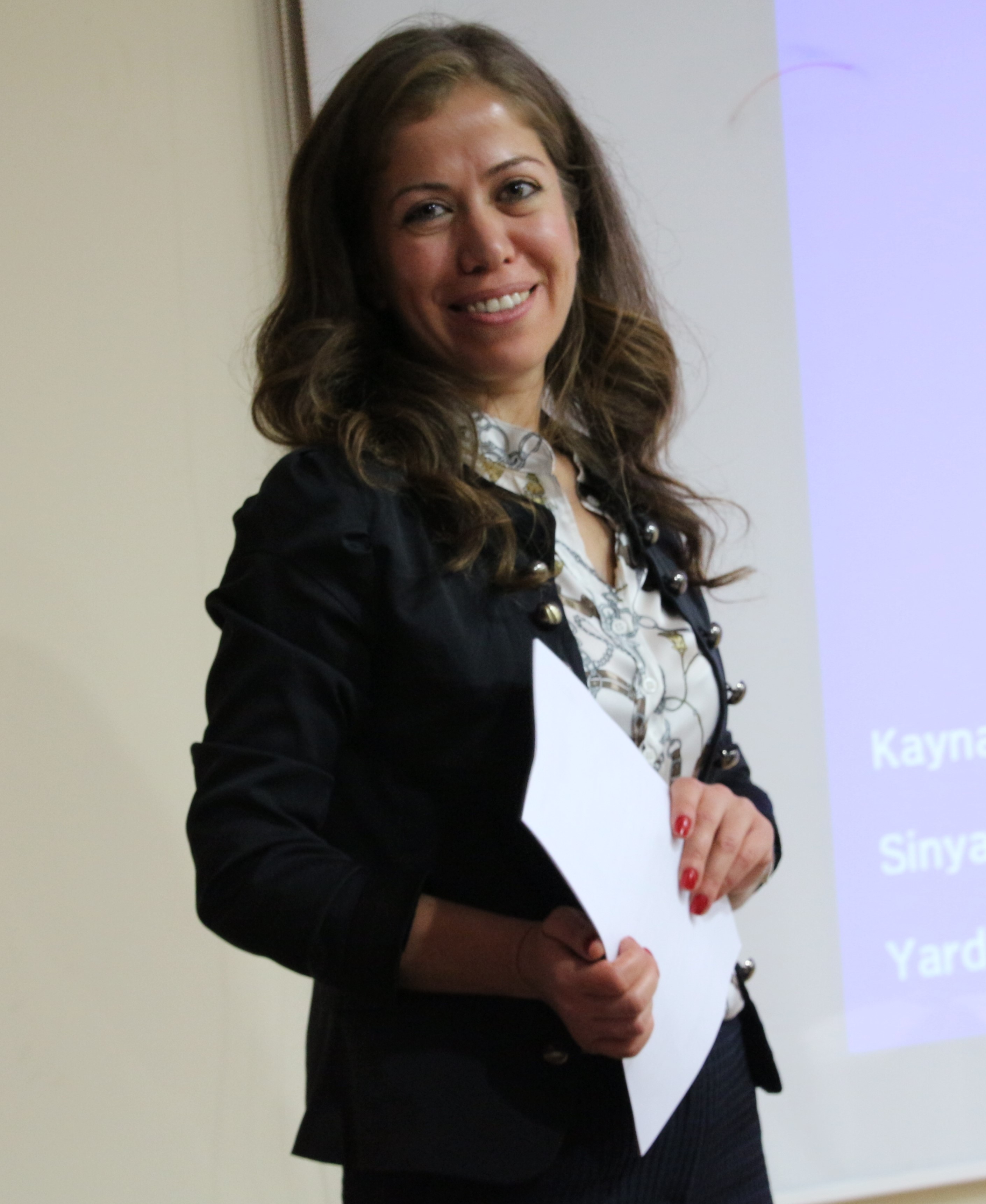
|
We welcome Assoc. Prof. Dr. Asli Cakir from the Department of Metallurgy and Materials Engineering, Mugla Sitki Kocman University, Turkey, who is supported by a fellowship granted by the Scientific and Technological Research Council of Turkey and will be with us until November 2022. Dr Cakir will carry out work on the investigation of interfacial pinning phenomena in artificial shell-ferromagnets by preparing multilayer Heusler films and studying their high-coercivity properties. During a previous visit to our laboratories in 2013, she had carried out research related to the construction of structural and magnetic phase diagrams of functional Heusler materials, which also made up the main theme of her PhD studies. Since then, we have been collaborating through mutual visits on the properties of magneto-structural transitions in Heusler alloys.
We wish her a fruitful and enjoyable stay in Duisburg..
|
|
2021-11-03: We WELCOME Sakia and Jonas in our team!
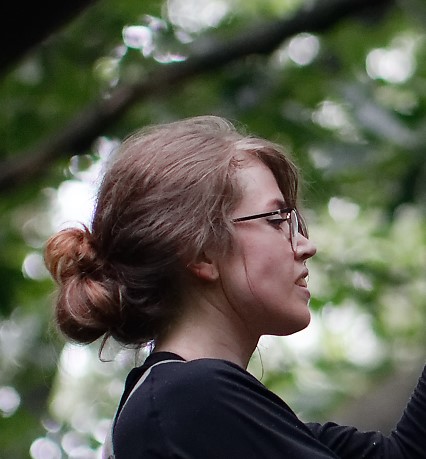 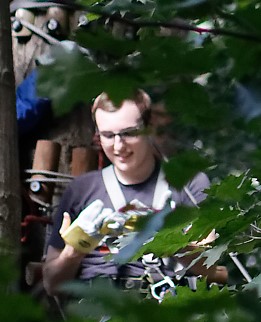 | B.Sc. Sakia Noorzayee und B.Sc. Jonas Wiemeler started their Master Theses (Physics) on Sept 1st, 2021 in our group.
Jonas will work with Anna Semisalova to produce ultraclean Fe/Rh films in UHV to better understand and describe the
Spin dynamics of ultrathin Fe/Rh multilayers.
And Sakia works with Nicolas Josten to improve The magnetic hysteresis of transition metal alloys through magnetic annealing exemplified by NiMn and CoTiGe.
We wish them a good time and excellent results! |
|
2021-10-19: Genauer geht nicht!
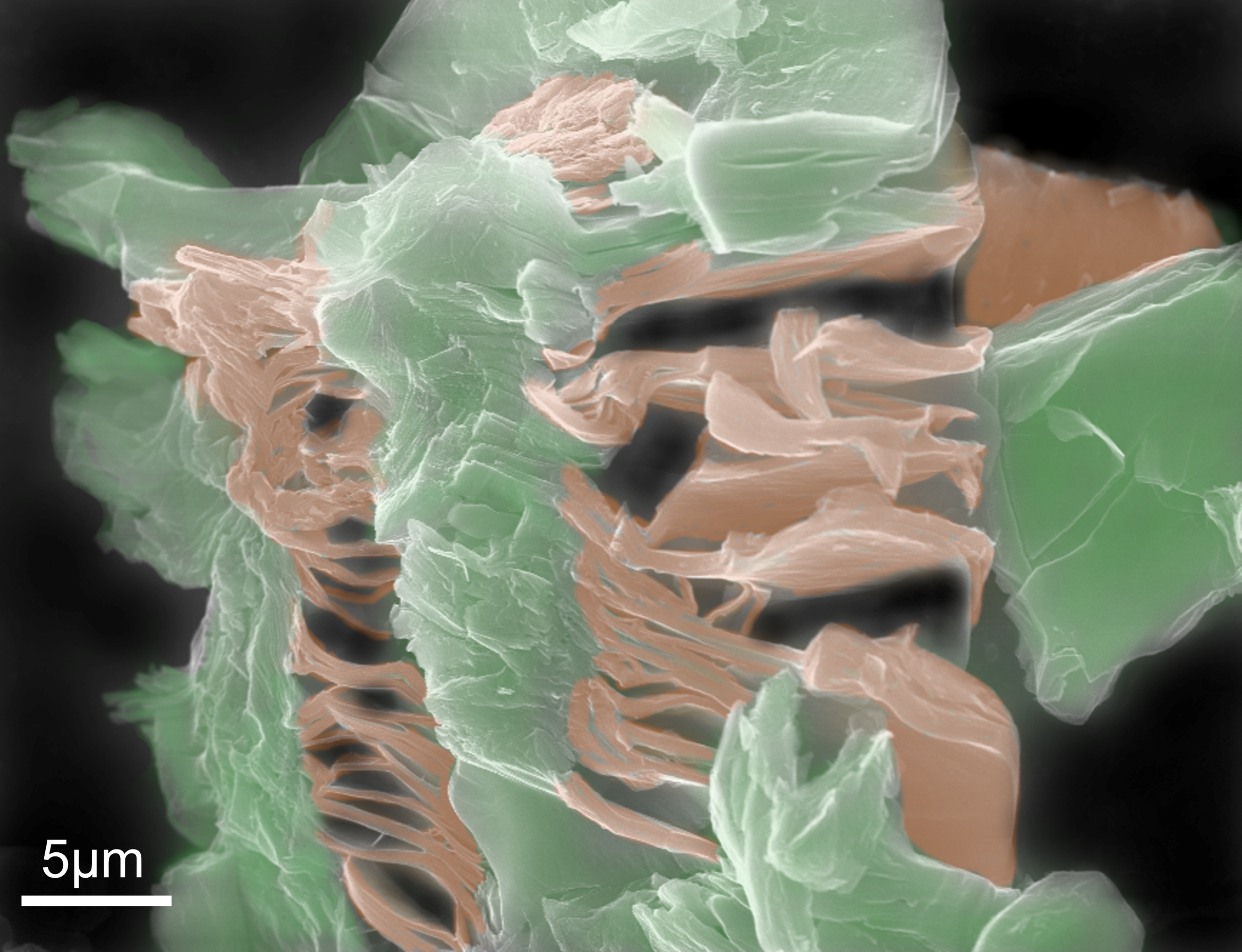
|
Neuartiger Sensor detektiert Wassermoleküle bei kleinsten Konzentrationen
Wissenschaftlerinnen und Wissenschaftlern der Universität Duisburg-Essen und der Staatlichen Technischen Universität Juri Gagarin in Saratow haben einen Sensor entwickelt, der Wassermoleküle erkennt, die auf seine Oberfläche sinken. Basis des Sensors sind MXene, zweidimensionale anorganischen Verbindungen, die aus nur wenige Atome dicken Schichten von Übergangsmetallcarbiden und -nitriden bestehen.
Die relative Luftfeuchtigkeit wird zu einem wichtigen Faktor, der komfortable und sichere Umgebungsbedingungen in der biomedizinischen Verarbeitung, der Mikroelektronik und der Gesundheitsüberwachung definiert und moderne Geräte zu seiner präzisen Kontrolle erfordert. Kommerzielle Sensoren, die auf voluminösen Materialien basieren, sind jedoch nicht in der Lage, sehr niedrige H2O-Konzentrationen (< 50 ppm) zu erkennen, was den Einsatzbereich der Sensoren erheblich einschränkt.
Ein Team von Wissenschaftlern der Universität Duisburg-Essen (Deutschland) und der Staatlichen Technischen Universität Juri Gagarin in Saratow (Russland) geht dieses Problem mit einer völlig neuen Strategie an. Sie verwenden zweidimensionale nanometrische Materialien, die in der Lage sind, kleinste Mengen Wassermoleküle zu erkennen, die auf ihre Oberfläche sinken. "Auf diese Weise verbessert sich die Sensorleistung enorm - die Nachweisgrenze wird weit unter den bisherigen Stand der Technik verschoben. Mehr geht eigentlich nicht.", freut sich die Erstautorin Hanna Pazniak. Sie ist seit Oktober 2020 an der UDE und forscht eigentlich zu magnetischen MAX-Phasen im Sonderforschungsbereich/Transregio 270 - "Hysterese-Design magnetischer Materialien für effiziente Energieumwandlung" in Teilprojekt B02. Die Entwicklung des neuen Sensors ist ein gutes Beispiel dafür, wie Forschung in kurzer Zeit auf andere Gebiete übertragen werden kann.
Die Schlüsselrolle spielten MXene - eine neue Klasse von zweidimensionalen Übergangsmetallcarbiden und -nitriden. Mo2CTx MXenes werden verwendet, die ein riesiges Verhältnis von Oberfläche zu Volumen aufweisen. Die entworfenen Sensoren zeigen eine höhere Empfindlichkeit als andere MXene gegenüber H2O-Dämpfen mit einer Nachweisgrenze von 10 ppm, was der niedrigste bisher bekannte Wert ist. Eine hohe Reproduzierbarkeit und eine Langzeitstabilität für mindestens 6 Monate sind weitere Eigenschaften, die für den Serieneinsatz Voraussetzung sind.
Insgesamt versprechen die herausragenden Eigenschaften der entwickelten Mo2CTx MXene viele mögliche Anwendungen, bei denen eine exakte Hygrometrie Voraussetzung ist. Die Forschungsergebnisse wurden kürzlich in der angesehenen Fachzeitschrift Advanced Materials veröffentlicht (https://doi.org/10.1002/adma.202104878).
Weitere Informationen:
Dr. Hanna Pazniak, Fakultät für Physik, hanna.pazniak@uni-due.de
Prof. Dr. Ulf Wiedwald, Fakultät für Physik, ulf.wiedwald@uni-due.de
|
|
2021-10-07: CONGRATULATIONS: Prof. apl. Dr. Ulf Wiedwald
Wir gratulieren Ulf herzlichst zur Ernennung zum außerplanmäßigen Professor der Fakultät für Physik.
Ulf hat nach einem Beginn an der TU Braunschweig, einem Zwischenstopp in Duisburg und Ulm sein wissenschaftliches Heim an unserer Fakultät und der Fakultät für Medizin seit einigen Jahren aufgebaut. Seine Arbeitsgebiete spiegeln diesen Spagat wieder. Einerseits untersucht er biomedizinische Fragestellungen, deren Beantwortung zur Entwicklung neuer Krebstherapien eingesetzt werden können, und andererseits beschreitet er neue Wege in der Herstellung sogenannter MAX-Phasen Materialien, die in den letzten Jahren ein exponentiell wachsendes Interesse aufgrund ihrer sehr speziellen Eigenschaften gefunden haben. |
2021-10-01: Dr. Natalia Shkodich neu in unserem Team
Wir begrüßen Dr. Natalia Shkodich (MISIS und ISMAM, Moskau, Russland) in unserem Team.
Sie wird als Junior-Gruppenleiterin im Rahmen des CRC / TRR 270 "Hysteresis design of Magnetic Materials for efficient energy conversion" an neuen "Super-Magneten" auf Basis innovativer Werkstoffe wie "High-Entropy Alloys (HEAs)" und verwandten "Compositionally complex magnetocalorics (CoCoMaCa)" forschen. Hierzu stehen hier die neuesten Apparaturen zur Analytik auf atomarer bis makroskopischer Skala zur Verfügung. Eine der Herausforderungen ist beispielswese die Verknüpfung der viel-elementigen Materialien zu einem Produkt, welches die elektrische Valenzelektronenkonzentration - und somit Eigenschaften - von Eisen hat, ohne Fe zu enthalten. Schwerpunkt der Synthese dieser Materialien, die aus 5 und mehr Elementen zusammengesetzt sein können, wird auf einem relativ neuen Verfahren des "High Energy Ball Milling" beruhen.
Studierende, die Interesse an der Mitarbeit in einem herausfordernden Projekt haben, melden sich bitte direkt bei Frau Dr. Shkodich (natalia.shkodich@uni-due.de) oder Prof. Farle (farle@uni-due.de") .
|
2021-09-30: Action Call of the European Raw Materials Alliance
The activities of the collaborative research center SFB/TRR 270 of which we are a partner started ahead of its time recognizing the importance of magnet technology for a carbon-neutral future of Europe.
Learn more about it here . |
2021-09-09: 25. Deutsche Physikerinnentagung
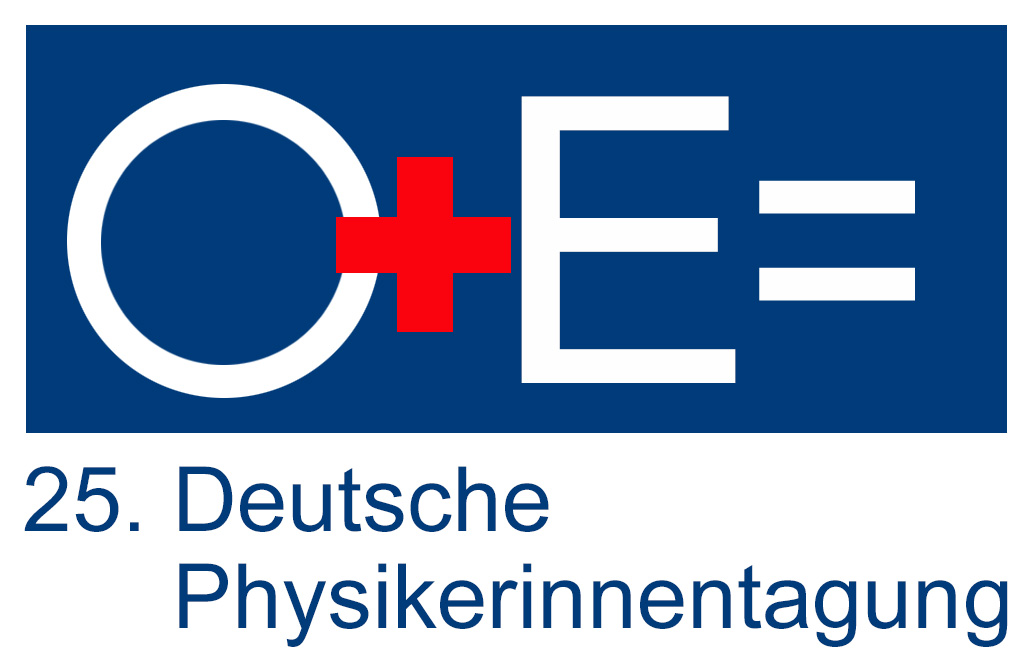

|
Vom 8. bis 10. November 2021 konzentriert sich die 25. Deutsche Physikerinnentagung drei Tage lang auf den fachlichen Austausch sowie auf die Karriereplanung und das Networking von Frauen in der Physik.
Zur Website der DPG
|
|
2021-08-24: 2nd Int. Workshop on Functional MAX Materials
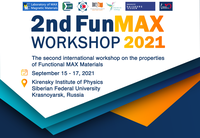
|
We are organizing an international workshop on the properties of Functional MAX Materials (2nd FunMAX 2021) at the Kirensky Institute of Physics and Siberian Federal University in Krasnoyarsk, September 14-17, 2021 in an ONLINE format. The 2nd FunMAX workshop will bring together scientists interested in the properties of MAX phase materials including their 2D derivatives (MXenes).
Registration is free and open till Aug 30.2021. Please use this link and send it to funmax@kirensky.ru.
|
|
2021-07-14: Förderzusage: Programm zur Förderung des exzellenten wissenschaftlichen Nachwuchses
Wir gratulieren Benjamin Zingsem zur Förderung seines Projekts "Towards Magnetic Resonance Observed by Transmission electron microscopy" durch die UDE. Die Förderung in Höhe von rund 30 k� erfolgt im Rahmen des Programms zur Förderung des exzellenten wissenschaftlichen Nachwuchses. |
2021-06-18: Würdigung für Dr. Benjamin Zingsem (Projekt Z02 des SFB/TRR 270)
Herr Dr. Benjamin Zingsem wurde im Rahmen des Dies Akademicus 2021 der Universität Duisburg-Essen für die beste Promotion 2020/21 an der Fakultät für Physik ausgezeichnet.
https://www.youtube.com/watch?v=bMltwjPdWZA
Wir freuen uns mit ihm und auf eine weitere Zusammenarbeit. |
2021-05-31: Theory predicts Magnetic Nutation Waves
|
2021-05-25: MaNaCa Training Workshop 2021
We are organizing a summer school as part of our European project with Armenia and Greece "Magnetic Nanoparticles for Cancer Therapy (MaNaCa)" (see for more details http://www.h2020-manaca.eu/). The conference will take place on June 16-18, 2021 in an online format. |
2020-11-10: Neue AG Mitglieder
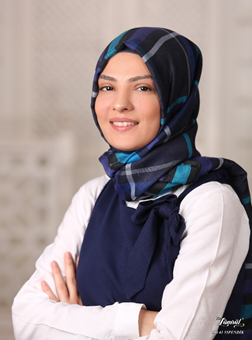
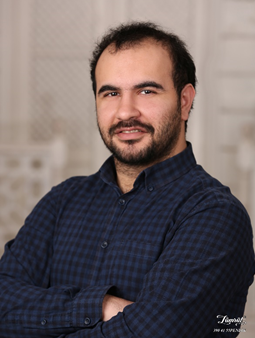
|
Wir freuen uns, Frau Kübra Yildiz Aktas und Herrn Ali Can Aktas begrüßen zu können, die im Rahmen eines Stipendiums des CRC/TRR 270 "Hommage" in den Projekten B09 und A04 an Shell ferromagnetic materials: Tuning the magnetic hysteresis by nanoscale selective phase decomposition und "Hierachical structuring of magnetocaloric materials with nanometer resolution" forschen werden.
|
|
2020-10-07: DAAD funded research stay of scientists from Russia
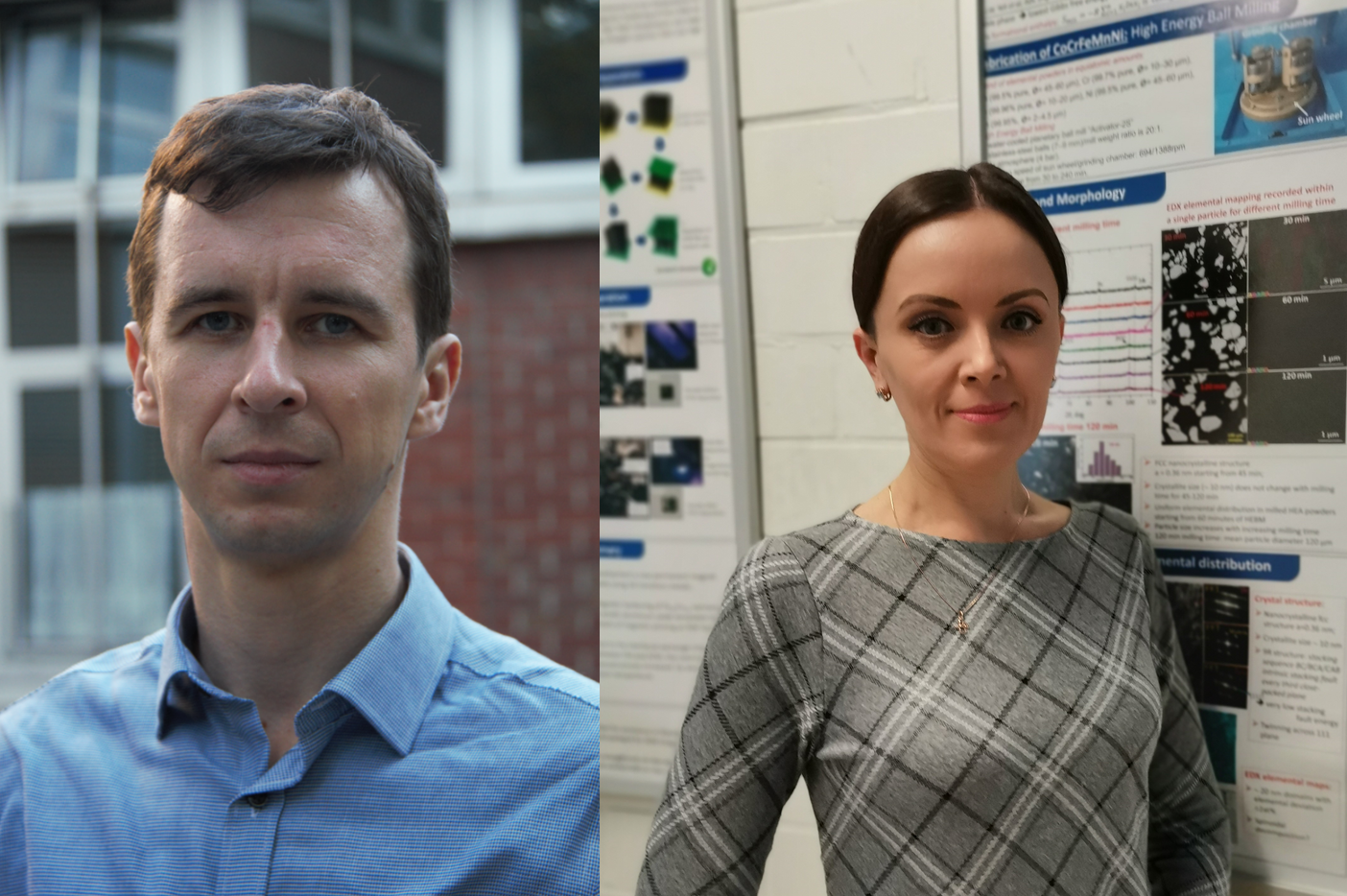
|
We welcome in our group Dr. Natalia Shkodich (Merzhanov Institute of Structural Macrokinetics and Materials Science, Russian Academy of Sciences) and Dr. Mikhail Cherkasskii (Saint Petersburg State University) who recently joined us for a 3 months research stay funded by DAAD scholarships ("Research stays for University Academics and Scientists, 2020" and "Dmitrij Mendeleev" Program).
Dr. Natalia Shkodich is an expert on combining High-Energy Ball Milling (HEBM) and Spark Plasma Sintering (SPS) to produce nanostructured and amorphous materials from immiscible metals (so-called pseudo alloys), metallic glasses, and high-entropy alloys (HEAs). She aims at producing novel nanostructured CoCrFeNiGa magnetic high entropy alloy (Mag HEA) particles and volume MagHEA materials with a large magnetization, high Curie temperature and tuneable coercivity as well as excellent mechanical properties.
Interests of Assoc. Prof. Dr. Mikhail Cherkasskii are focused on the understanding of magnetization nutation in ferromagnets and its coupling to precession and ferromagnetic resonance. He is working on the development of an analytical approach to describe inertial spin dynamics, nutation resonance and collective excitations in ferromagnets.
|
|
2020-09-15: Auszeichnung für Priv.-Doz. Dr. Ulf Wiedwald und Kollegen
Ma�geschneiderte Winzlinge gegen den Krebs
Ihre Nanopartikel aus Gold und Magnetit haben sie speziell für die Diagnose und Therapie von Tumoren entwickelt: Physiker vom Center for Nanointegration (CENIDE) der Universität Duisburg-Essen (UDE) und Moskauer Kollegen werden am 15. September für ihre erfolgreiche Zusammenarbeit ausgezeichnet (CENIDE: News). |
2020-07-24: New publication in AIP Advances - Editors Pick!
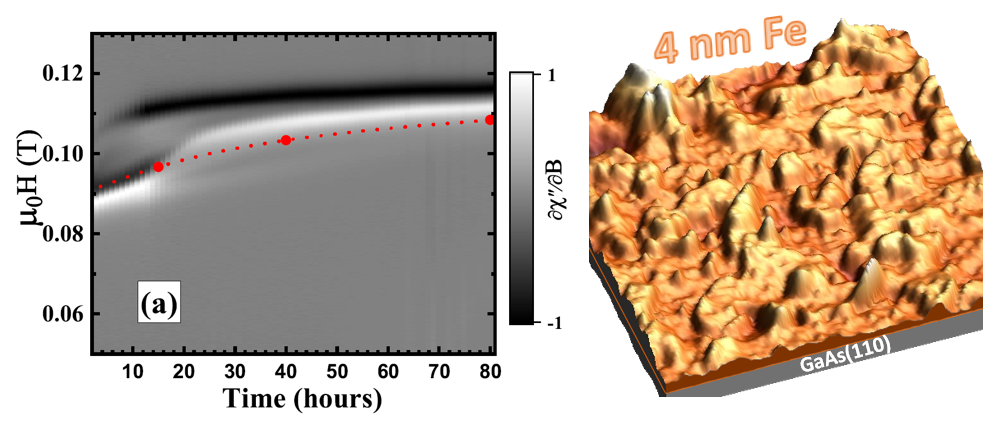
|
Reversal of uniaxial magnetic anisotropy in Fe/GaAs (110) films driven by surface relaxation: An in situ ferromagnetic resonance study by Babli Bhagat et al.
Performing in situ studies of ferromagnetic resonance in thin metallic films in ultrahigh vacuum, we found a dramatic change of in-plane magnetic anisotropy in 4 nm Fe film grown on GaAs(110) substrate occurring after deposition. Initially grown, Fe/GaAs(110) film exhibits unusual uniaxial in-plane anisotropy which reverses its sign within 40 hours while the film is kept in vacuum at room temperature. The effect of surface contamination has been excluded using surface-sensitive techniques AES and LEED, which let us to conclude on metastability and ongoing surface relaxation of Fe film. This finding opens up a further study of such island-like grown metastable thin films where magneto-morphological transitions can be altered by temperature and other external stimuli.
|
|
2020-05-29: Doktorandenstellen
|
In unserer Arbeitsgruppe sind Doktorandenstellen zum nächstmäglichen Zeitpunkt zu folgenden Projekten zu besetzen:
B09: "Hierarchical structuring of magnetocaloric materials with nm resolution"
|
|
2020-07-03: Neues Gleichstellungsteam
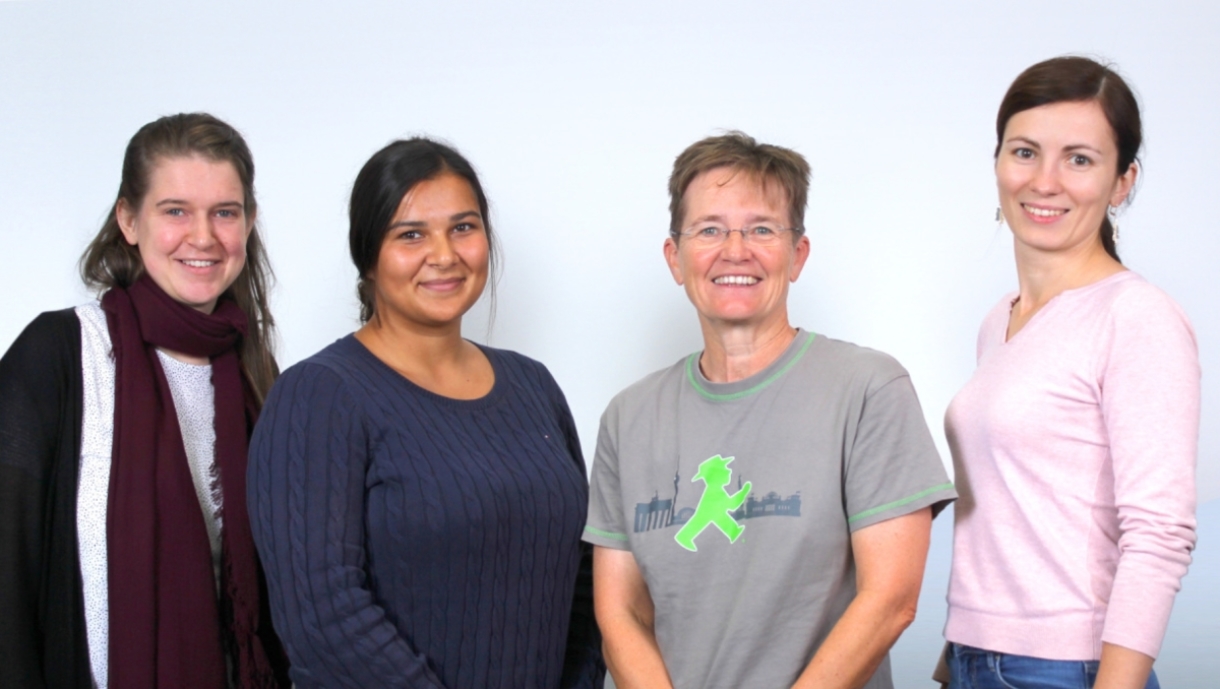
|
Seit dem 25.09.2019 gibt es an der Fakult�t f�r Physik ein neues Gleichstellungsteam, darunter auch unsere Mitarbeiterin Dr. Anna Semisalova (rechts), die zusammen mit Dr. Katharina Ollefs und Samira Webers (2. v.l.), die als Stellvertreterinnen zusammen mit Prof. Marika Schleberger (2. v.r.), die Gleichstellungsbeauftragte Cornelia Geller (l.) unterst�tzen. Ziel ist es, den Grundsatz der Gleichberechtigung von Frauen und M�nner an der Fakult�t f�r Physik zu ber�cksichtigen. Darunter versteht sich die F�rderung zur Gewinnung und Qualifizierung von Studentinnen und Mitarbeiterinnen und die Vereinbarkeit von Studium, Beruf und Familie zu verbessern.
Link zu Angeboten der Gleichstellung Physik
|
|
2020-03-10: Non-standing spin-waves in confined micrometer-sized ferromagnetic structures under uniform excitation
Editors Pick (!)
Non-standing spin-waves in confined micrometer-sized ferromagnetic structures under uniform excitation
Appl. Phys. Lett. 116, 072401 (2020); https://doi.org/10.1063/1.5139881
Santa Pile et al.
A long effort within an international collaboration (U. Linz, Duisburg-Essen, Stanford) including partners from the CRC/TRR 270 broke new ground in element-specific magnetic imaging with picosecond temporal and few nanometer spatial resolution. A non-standing characteristic of directly imaged spin-waves in confined micrometer-sized ultrathin Permalloy (Ni80Fe20) structures is reported along with evidence of the possibility to alter the observed state by modifications to the sample geometry. |
2020-03-10: Dynamic unidirectional anisotropy in cubic FeGe with antisymmetric spin-spin-coupling
Nicolas Josten, et al. Scientific Reports 10, 2861, (2020)
DOI: 10.1038/s41598-020-59208-8
Successful collaboration with TU-Darmstadt within CRC/TRR 270. We studied bulk polycrystalline B20 FeGe samples prepared in Darmstadt and measured ferromagnetic resonance spectroscopy. As a result we discovered strong (dynamical) unidirectional anisotropy. Such anisotropy is not present in static magnetometry measurements. B20 FeGe exhibits inherent Dzyaloshinskii-Moriya interaction, resulting in a nonreciprocal spin-wave dispersion. By X-band ferromagnetic resonance spectroscopy at 276 K � 1 K, near the Curie temperature, a distribution of resonance modes was observed in accordance with the cubic anisotropy of FeGe. This distribution exhibits a unidirectional anisotropy, i.e. shift of the resonance field under field inversion, of KUD = 960 J/m3 � 10 J/m3, previously unknown in bulk ferromagnets. Additionally, more than 25 small amplitude standing spin wave modes were observed inside a micron sized FeGe wedge, measured at 293 K � 2 K. These modes also exhibit unidirectional anisotropy. This effect, only dynamically measurable and not detectable in static magnetometry measurements, may open new possibilities for directed spin transport in chiral magnetic systems. |
2020-01-17: Highlighted Publication
 |
The publication based on our long term collaboration with the group of Ver�nica Salgueiri�o (university of Vigo, Spain) �Shaping iron oxide nanocrystals for magnetic separation applications� has been selected to be a part of a themed collection International Year of the Periodic Table: As attractive as magnets � applications for magnetic materials. This themed collection is the seventh, and final, in a series celebrating the International Year of the Periodic Table. �As Attractive as Magnets � Applications for Magnetic Materials� features papers from across the Materials and Nano journal portfolio; Materials Horizons, Nanoscale Horizons, Nanoscale, Nanoscale Advances and Journal of Materials Chemistry A, B & C. The papers selected for this themed issue focus on the current hot trends in the field of magnetic materials.
| |
2019-11-26: Cooperate Research Center TRR 270 HoMMage
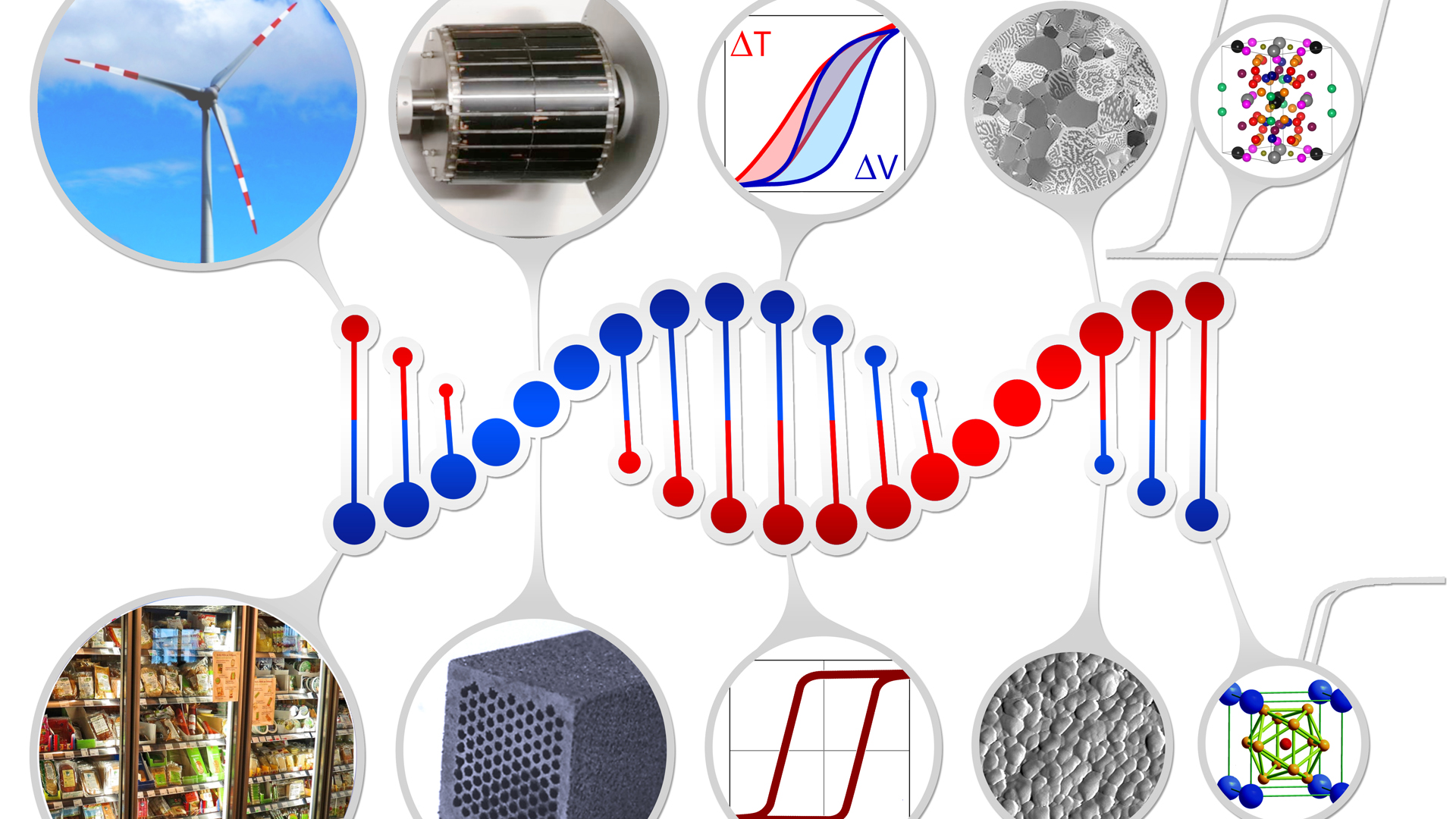
|
We celebrate the new Cooperate Research Center TRR 270 HoMMage "Hysteresis Design of Magnetic Materials for Efficient Energy Conversion".
Starting Jan 1st, 2020 we will design and develop magnetic materials for applications in electro mobility, robotics and energy converters over the first period till Dec. 31st , 2023.
In our group we have three positions for Ph.D. students available on projects related to this programme (see separate announcements).
|
|
2019-09-26: Workshop SpinS-2019 gathers experts in nanomagnetism at the University of Duisburg-Essen
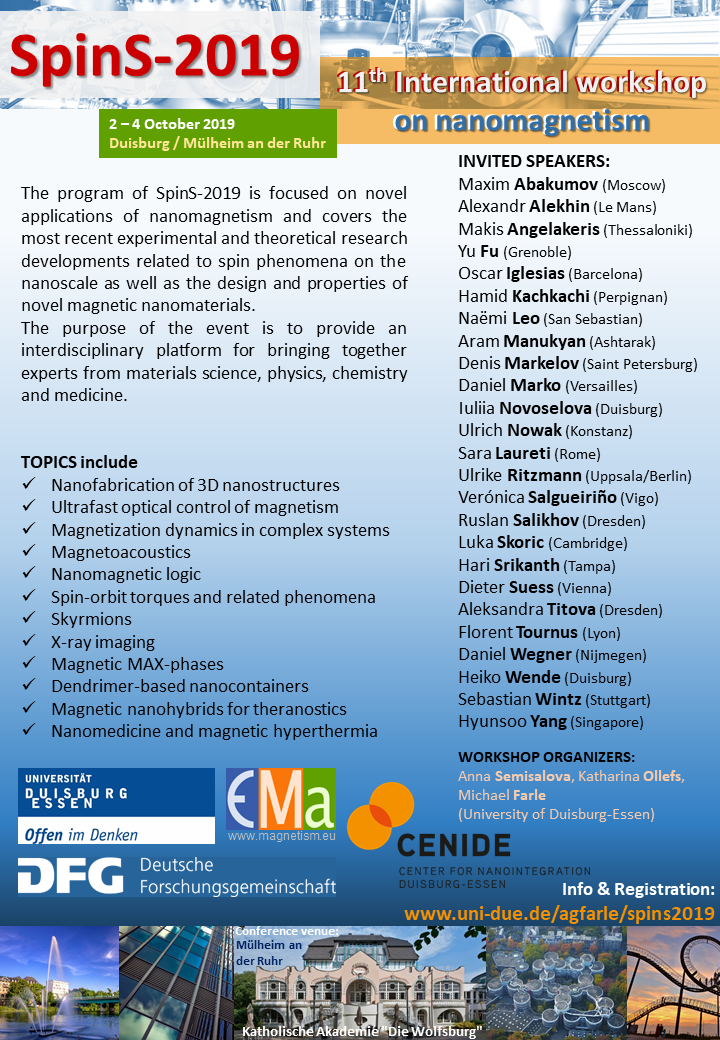
|
Next week, 2-4 October 2019, more than 40 experts in physics, chemistry and materials science from 12 countries meet in “Die Wolfsburg” Academy in Mülheim an der Ruhr/Duisburg to share their research results and discuss new concepts in nanomagnetism and its applications, like energy-efficient computing and magnetic refrigeration.
The Workshop program covers the most recent experimental and theoretical research developments related to spin phenomena in nanoscale systems as well as the design, properties and applications of magnetic nanomaterials. It includes several emergent technologies based on spin-orbit torques, ultrafast spin dynamics in THz frequency range, magnonics, magnetoacoustics as well as novel materials like shell-ferromagnets, MAX phases (including 2D MXenes), and nanohybrids for theranostics applications actively developed in the working group AG Farle. The SpinS-2019 provides an interdisciplinary platform for meeting the specialists in fabrication and imaging of 2D and 3D magnetic nanostructures, and experts working towards various application areas – from spin dynamics and magnetic memory to additive manufacturing and biomedicine.
The meeting is organized by Michael Farle, Katharina Ollefs and Anna Semisalova, with a technical support of Michael Vennemann and Sabina Grubba. Organizers highly appreciate the financial support of the Center for Nanointegration Duisburg-Essen (CENIDE).
SpinS-2019 website
Flyer
|
|
2019-09-26: High Entropy Alloys: How to induce ferromagnetism?
High-entropy alloys are currently the focus of significant attention in materials science and engineering. Some HEAs have considerably better strength-to-weight ratios, with a higher degree of fracture resistance, tensile strength, as well as corrosion and oxidation resistance than conventional alloys. In the recent publication Mehmet Acet showed how to introduce strong magnetism in a Cr20Mn20Fe20Co20Ni20 high-entropy alloy. He could show through the thermal expansion properties that the alloy carries similar anti-Invar properties as FCC-Fe, but unlike FCC-Fe it is stable throughout its solid-state temperature range. Therefore, by exploiting the anti-Invar property and expanding the lattice of the alloy by introducing interstitial carbon, we make Cr20Mn20Fe20Co20Ni20 ferromagnetic with a Curie temperature lying above room temperature.
For details see: https://doi.org/10.1063/1.5120251
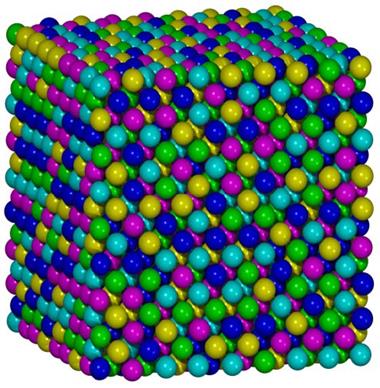
|
Picture from Von Shaoqing Wang - Wang, Shaoqing (13 December 2013). "Atomic Structure Modeling of Multi-Principal-Element Alloys by the Principle of Maximum Entropy". Entropy 15 (12): 5536�5548. DOI:10.3390/e15125536., CC BY 3.0, https://commons.wikimedia.org/w/index.php?curid=32060405
|
|
2019-09-26: A novel concept for bio-inspired architectures
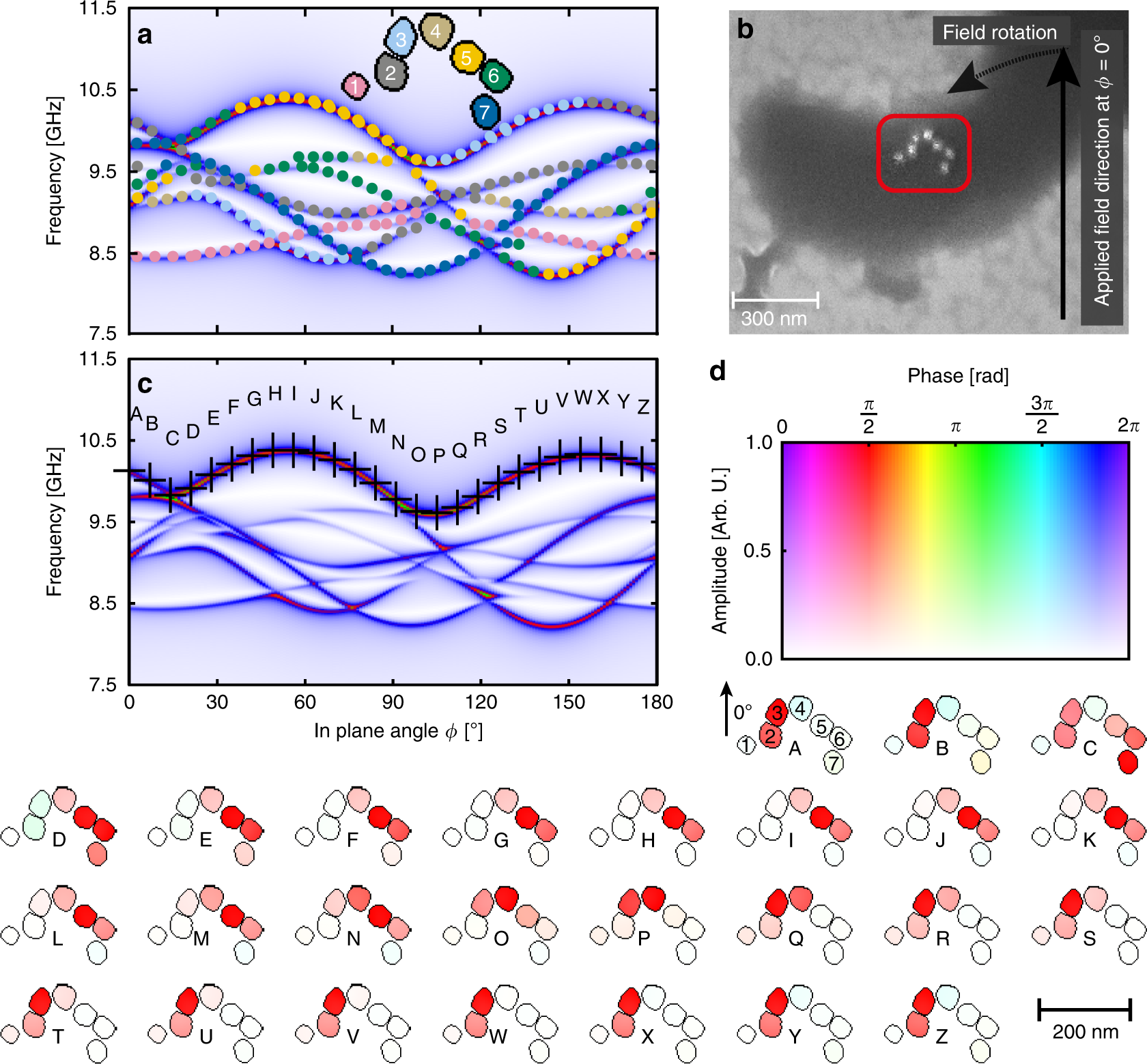
|
A novel concept for bio-inspired architectures in up-scalable, energy efficient computing is discussed in our recent publication "Biologically encoded magnonics". For details read here (https://www.nature.com/articles/s41467-019-12219-0)
|
2019-05-20: Magnetite-Gold nanohybrids as ideal all-in-one platforms for theranostics
Maria V. Efremova, Victor A. Naumenko, Marina Spasova, Anastasiia S. Garanina, Maxim A. Abakumov, Anastasia D. Blokhina, Pavel A. Melnikov, Alexandra O. Prelovskaya, Markus Heidelmann, Zi-An Li, Zheng Ma, Igor V. Shchetinin, Yuri I. Golovin, Igor I. Kireev, Alexander G. Savchenko, Vladimir P. Chekhonin, Natalia L. Klyachko, Michael Farle, Alexander G. Majouga and Ulf Wiedwald
was published in Scientific Reports in July 2018 and is listed by the journal among the top 25 articles in the collection 'Chemistry Top 100' articles in 2018. This list is based on most highly accessed chemistry articles covering January-December 2018.
(DOI: 10.1038/s41598-018-29618-w | https://www.uni-due.de/agfarle-archiv/highlights)
| 2019-04-29: Energy Technology "Best of 2018"
Our review article "Hysteresis Design of Magnetocaloric Materials - From Basic Mechanisms to Applications"
Franziska Scheibel, Tino Gottschall, Andreas Taubel, Maximilian Fries, Konstantin P. Skokov, Alexandra Terwey, Werner Keune, Katharina Ollefs, Heiko Wende, Michael Farle, Mehmet Acet, Oliver Gutfleisch, Markus E. Gruner, (Collaboration partners from TU Darmstadt and U. Duisburg-Essen)
published in Energy Technology in 2018 has been named one of the top articles of the year as the "Best of 2018".
This selection is based upon the download and citation numbers as well as the opinions and feedback of the editorial office of the journal.
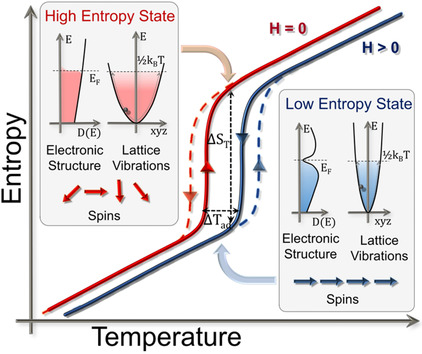
|
Understanding hysteresis: Materials with magnetostructural phase transitions (MSPT) show a large magnetocaloric effect (MCE). The understanding of MSPT and its thermal hysteresis requires the knowledge about the electronic, magnetic, and lattice entropy contributions. In this Review, we provide an overview of the properties of MSPT in La-Fe-Si, Heusler alloys, Mn3GaC, and Fe2P‐type materials with respect to the MCE and its reversibility based on studies under static/dynamic conditions at micro‐ and mesoscopic scales.
|
| 2019-04-10: MA PhD Focus Session "Biogenic Spin Phenomena", DPG SKM Spring Meeting, Regensburg, March 31- April 5, 2019
The PhD Focus session "Biogenic Spin Phenomena", which was organized by Ph.D. students from the group of M. Farle, H. Wende and T. Weßels from FZ Jülich, assembled a group of prominent experts to share insights and perspectives of Biomagnetism. The symposium with about 80 participant and funded by the DPG was successful and established new links between research groups.
Link: https://www.dpg-verhandlungen.de/year/2019/conference/regensburg/part/ma/session/27
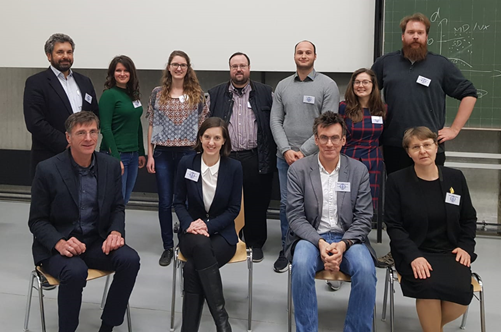
The picture shows: Front row: Prof. M. Winklhofer, Prof. C. Monzel, Prof. R. Dunin-Borkowski, Prof. G. V. Kurlyandskaya; Back row: Prof. M. Farle, I. Iglesias, T. Weßels, Th. Feggeler, N. Rothenbach, I. Novoselova, B. Zingsem. We thank all speakers for their excellent contribution and an extraordinary panel discussion. For us, PhD students, the organization of the event was a great experience. We are very grateful to the DPG, the jDPG, the University of Duisburg-Essen, and the Forschungszentrum Jülich for enabling this experience. In particular, we would like to acknowledge the Center of Nanointegration of Duisburg-Essen University CENIDE for financial support.
Organization Committee:
Iuliia Novoselova (iuliia.novoselova@uni-due.de)
Thomas Feggeler (thomas.feggeler@uni-due.de)
Irene Iglesias (irene.iglesias@uni-due.de)
Nico Rothenbach (nico.rothenbach@uni-due.de)
Teresa Weßels (t.wessels@fz-juelich.de)
Benjamin Zingsem (benjamin.zingsem@uni-due.de)
| 2019-04-10: MA Focus Session �Magnetic Materials for Energy Efficient Applications�, SKM Spring Meeting, Regensburg, March 31- April 5, 2019
Coordinators:Katharina Ollefs (katharina.ollefs@uni-due.de), Franziska Scheibel (scheibel@fm.tu-darmstadt.de)
The focus session which was organized by Franziska Scheibel and Katharina Ollefs turned out to be a success after having been selected by the biggest Magnetism Association ("Fachverband Magnetismus" of DPG) of the world as one of its 5 Focus session in 2019.
High performance magnetic materials are at the heart of many energy-related technologies, such as direct drive wind turbines and e-mobility. They are also important in robotics and automatization, sensors, actuators, and information technology as well as in solid state-based refrigeration. All of these technologies are expected to grow significantly in the next decades and especially, so-called green energy technologies are likely to see an exponential increase. Several international experts in the field of permanent magnets and magnetocalorics reported on different aspects of magnetic materials:
Microstructure optimization for rare-earth efficient permanent magnets (Thomas Schrefl)
Advanced methods for the development of high performance hard and soft magnetic materials (Dagmar Goll)
Compositionally graded films as model systems to study magnetic materials for energy applications (Nora Dempsey)
Dissecting the magneto-structural transformation in materials with first-order field-induced transitions (Konstantin Skokov)
The Organizers thank for the support by the �Sektion Kondensierte Materie� of the �Deutsche Physikalische Gesellschaft�.
| 2019-03-18: 69th Lindau Nobel Laureate Meeting (30 June�5 July 2019) with Iuliia Novoselova and Benjamin Zingsem
Only 600 young scientists from around the world are invited to participate at the 69th Lindau Nobel Laureate Meeting ( https://www.mediatheque.lindau-nobel.org/meetings/2019 ) dedicated to physics . They have the chance to meet and discuss with 41 Nobel Laureates� including the 2018 laureates in physics Donna Strickland and G�rard Mourou.
Congratulations to our Group Members !!! | 2019-03-05: Neue Mitarbeiterin: Dr. Anna Semisalova
 New colleague: Dr. Anna Semisalova New colleague: Dr. Anna Semisalova
We welcome Dr. Anna Semisalova as a new colleague and Habilitation candidate in our group.
Anna brings a DFG-funded project to the University of Duisburg-Essen and is looking for students for bachelor or master theses on topics related to spin dynamics and magnonics.
Also, a PhD position for investigation of magnetization dynamics in nanostructures is available.
| 2019-03-04: PhD students organizing PhD focus session
Magnetism in Biology and Medicine
 Young scientists at the University Duisburg-Essen, RWTH Aachen and the Forschungszentrum J�lich organize a symposium at Europe�s largest physics congress. Participants of the DPG meeting in Regensburg are encouraged to join the symposium on 3rd April, 2019. No further registration is required.
Young scientists at the University Duisburg-Essen, RWTH Aachen and the Forschungszentrum J�lich organize a symposium at Europe�s largest physics congress. Participants of the DPG meeting in Regensburg are encouraged to join the symposium on 3rd April, 2019. No further registration is required.
The invited talks will cover innovative discoveries ranging from theranostic (theranostics = combination of therapy and diagnostics) over biogenic to bioinspired research areas, featuring renowned scientists from Europe and the US:
Prof. Dr. Kannan M. Krishnan (University of Washington, USA)
Prof. Dr. Galina V. Kurlyandskaya (University of the Basque Country, Spain)
Prof. Dr. Cornelia Monzel (Heinrich-Heine University D�sseldorf, Germany)
Prof. Dr. Michael Winklhofer (Carl von Ossietzky University of Oldenburg, Germany)
The topic of the symposium revolves around magnetism in biomedical applications,
magnetic materials for biodetection, biomimetics and spin dynamics of individual biogenic magnetic nanoassemblies.
The symposium will conclude with a panel discussion, aiming to allow participants to get in contact with the experts and formulate future perspectives for Biomagnetism. Prof. Dr. Michael Farle kindly agreed to moderate the panel.
Further information can be found
here.
Organizing committee
We are PhD students:
Iuliia Novoselova (University of Duisburg-Essen and CENIDE)
Thomas Feggeler (University of Duisburg-Essen and CENIDE)
Irene Iglesias (University of Duisburg-Essen and CENIDE)
Nico Rothenbach (University of Duisburg-Essen and CENIDE)
Teresa We�els (Forschungszentrum J�lich and RWTH Aachen University)
Benjamin Zingsem (University of Duisburg-Essen and CENIDE and Forschungszentrum J�lich)
| 2019-01-22: Dr. Merivan Sasmaz from Adiyaman University in our group
 We welcome Dr. Merivan Sasmaz from the Physics Department, Adiyaman University, Turkey in our group.
We welcome Dr. Merivan Sasmaz from the Physics Department, Adiyaman University, Turkey in our group.
She successfully completed a DAAD sponsored project working in our group for two months. Now, she received a one year research grant from TUBITAK (Turkish Research Foundation) for the "Investigation of the effects of magnetic proximity effect on the magnetocaloric properties of Ni-Mn based Heusler alloys" We congratulate her on her success with DAAD and TUBITAK and look forward to a fruitful collaboration. | 2018-04-11: Ehrung f�r M. Farle
Michael Farle has been honored with the degree of �Adjunct Professor� at the Sharif University of Technology (Teheran, Iran, http://www.en.sharif.edu/ ). Founded in 1966, the university has a reputation in Iran as being one of the country�s most prestigious higher education institutions. It offers a range of graduate and postgraduate degrees in its 15 departments. Admission for undergraduates wishing to study at Sharif University of Technology is tough. Only those obtaining the top 5 per cent of scores in Iran�s national entrance examination, carried out by the country�s Ministry of Culture and Higher Education, can enroll.� | 2017-09-01: Ulf Wiedwald ist Gastprofessor in Moskau
 In 2017 and 2018, PD Dr. Ulf Wiedwald will temporarily exchange the Salvatorkirche for the St. Basil's Cathedral and the Magic Mountain for the Red Square: He prevailed in an international competition and has been appointed as visiting professor at the renowned National University of Science and Technology (NUST) �MISiS� in Moscow, Russia.
In 2017 and 2018, PD Dr. Ulf Wiedwald will temporarily exchange the Salvatorkirche for the St. Basil's Cathedral and the Magic Mountain for the Red Square: He prevailed in an international competition and has been appointed as visiting professor at the renowned National University of Science and Technology (NUST) �MISiS� in Moscow, Russia.
Wiedwald has been cooperating with Prof. Alexander Majouga and Dr. Maxim Abakumov from the "Biomedical Nanomaterials Laboratory" and Prof. Alexander Savchenko from the Department of Physical Materialogy in NUST �MISiS� for a long time now. Together, they have been working on particles for theranostics: magnetic nanomaterials, which can simultaneously be used for the diagnosis and therapy of cancer diseases.
For a period of three weeks each, the physicist will be visiting NUST �MISiS� twice, in 2017 and 2018. In addition to research, teaching and working on the joint project will be on the agenda.
Wiedwald is particularly interested in the cooperation for two aspects: "For a successful implementation of our project, we have to combine different research disciplines, which I find very enriching. Moreover, I am looking forward to learn more about the Russian
culture and mentality, which I have already appreciated during my previous visits."
Further information:
PD Dr. Ulf Wiedwald, 0203 379-2633
ulf.wiedwald@uni-due.de
Redaktion: Birte Vierjahn, 0203 379-8176
birte.vierjahn@uni-due.de | 2017-06-28: Breakthrough in forming Fe containing MAX Phases
The first Fe-based MAX phase is realized by solid-state substitution reaction of an Fe/Au/Mo2GaC. Chemical analysis together with elemental mapping reveals that as much as 50 at.% Fe on the A site can be obtained by thermally induced Au and Fe substitution for Ga atomic layers in Mo2GaC. This finding is an important step towards synthesizing oxidation and wear resistant, nanoscale laminated magnetic MAX Phases with large magnetization and higher Curie temperature.

For details see Chung-Chuan Lai et al. https://doi.org/10.1080/21663831.2017.1343207 | 2017-02-01: Mehmet Acet und Asli Cakir entdecken neuartigen Magneten
Mehmet Acet und Asli Cakir entdecken Magneten mit dem Verhalten eines �Monopols�
Pressemeldung: "Durch Zufall: Duisburger Physiker entdeckt besonderen Magneten" | 2016-10-31: Michael Farle is one of four recipients of the 2017 Distinguished Lecturer Awards
Michael Farle is one of the four recipients of the 2017 Distinguished Lecturer Awards of the IEEE Magnetics Society. The price money (20.000 US$ ) is intended to cover travel expenses for lectures around the globe in 2017 (Details).
| 2016-09-14: 250 000 � gleich beim ersten Antrag
Dr. Florian M. R�mer war gleich bei seinem ersten DFG-Antrag sehr erfolgreich.
Das drei Jahre andauernde Projekt beinhaltet die Finanzierung eines Doktoranden und diverse Sachmittel. Dr. R�mer wird im Rahmen dieses Projektes die D�mpfungseigenschaften der Ferromagnet/ Nichtferromagnet Grenzfl�che mit Hilfe von in situ multifrequenter Ferromagnetischer Resonanz untersuchen. Einer der Gutachter erwartet "einen enormen Erkenntnisgewinn zum spin pumping", welcher f�r weitere "Forschungsfelder, die Spin-Transfer-Torque-Effekte nutzen, zudem f�r hochaktuelle spinkalorische Effekte und den Spintransistor" relevant sein wird. Die inoffizielle (offizielle folgt) Stellenausschreibung ist hier zu finden. In diesem Bereich sind ebenfalls Bachelor- und Masterarbeiten zu vergeben! | 2016-06-07: 07.06.2016 DFG Projekt SA 3095/2-1
Wir gratulieren unserem Mitarbeiter Dr. Ruslan Salikhov zur erfolgreichen Einwerbung eines DFG Projektes zum Thema: �Magnetische Anisotropie und Relaxation in einer neuen Materialklasse: Nanolaminierte magnetische MAX Phasen�. Das dreij�hrige Forschungsvorhaben, welches am 1.7.2016 beginnt, wird mit einer Gesamtsumme von rund 280.000 � gef�rdert. Wir freuen uns mit ihm und feiern !!! Anfragen bez�glich Master � oder Bachelorarbeiten sind willkommen. Weitere Infos: Ruslan.Salikhov@uni-due.de. | 2016-06-07: 07.06.2016 Alexander von Humboldt (AvH) Forschungspreistr�ger Kannan Krishnan
Seit dem 7.6.2016 ist Prof. Kannan Krishnan von der University of Washingthon in unserer Arbeitsgruppe. Er wird zun�chst f�r zwei Monate bei uns sein und uns mit Rat und Tat in den Forschungsaktivit�ten unserer Arbeitsgruppe begleiten. Eine R�ckkehr f�r den Herbst und im n�chsten Jahr ist geplant. Zusammen mit AvH Forschungspreistr�ger Prof. Dieter Weller, der seit Anfang des Jahres bei uns ist, freuen wir uns auf die internationale Expertise der internationalen Kollegen vertrauen zu d�rfen. Anfragen bzgl. Bachelor- und Masterarbeiten sind willkommen. farle@uni-due.de | 2016-06-07: 07.06.2016 Prof. Igor Barsukov (University of California at Riverside)
Wir gratulieren unserem fr�heren wissenschaftlichem Mitarbeiter Dr. Igor Barsukov zur Ernennung als Assistant Professor an der UC Riverside am 7.6.2016. Seine Forschungsaktivit�ten werden sich auf die Terahertzspektroskopie an metallischen und oxidischen magnetischen Materialien konzentrieren. Das Verst�ndnis von komplexen Spin-dynamik Effekten, die in zuk�nftigen Magnetotronik und nanoskaligen Spin-Logik Bauelementen Anwendung finden, ist ein Schwerpunkt seiner Forschung. Wir gratulieren und freuen uns, weiter mit ihm zusammenarbeiten zu k�nnen. | 2016-04-29: 01.04.2016 Auf in die Industrie: Dr. Sara Liebana-Vinas geht zu Evonik
Nach Ihrer erfolgreichen Promotion mit internationaler Betreuung im Grenzgebiet zwischen kolloidaler Chemie und Nano-Festk�rperphysik verlies uns Sara, um in der Industriellen Projektentwicklung bei EVONIK Ihr Gl�ck zu suchen. Wir bedauern Ihren Weggang und w�nschen alles Gute. Hasta Luego ! | 2016-04-29: 28.04.2016 Verleihung des Forschungspreises der Alexander von Humboldt � Stiftung an Prof. Kannan Krishnan (University of Washington)
Prof. Krishnan http://depts.washington.edu/kkgroup/ is well-recognized as an internationally leading expert in elucidating structure property relations at relevant length scales in a wide range of magnetic, superconducting and spintronics materials. He has made outstanding contributions that have been widely recognized with numerous awards. Prof. Krishnan has co- pioneered studies of exchange, proximity and interface effects in magnetic thin films and nanostructures. Further, he was one of the first to explore semiconductor-magnetic thin film integration and identify a new class of spintronic materials called Dilute Magnetic Dielectrics �� TM-doped wide band-gap semiconductors �� that are both insulating and ferromagnetic. At present, based on his other interdisciplinary work over the last 15 years, he is considered as one of the leading authorities on Biomedical Nanomagnetics �� the development and use of nanoscale magnetic particles/tracers in biomedical imaging, diagnostics and therapy and their translational applications in angiography and molecular imaging for cancer. Last but not least, Prof. Krishnan is recognized as an outstanding educator and communicator (e.g. IEEE distinguished lecturere) and his single author, 800-page book entitled "Fundamentals and applications of magnetic materials", to be published by Oxford University Press in 2016, is expected to be the seminal work in the field. Prof. Kannan Krishnan will be hosted by our group at the University of Duisburg Essen starting in June 2016. | 2016-04-29: 01.03.2016 Auf in die Promotion: M.Sc. Nanoeng. Alexandra Terwey und M.Sc. Sabrina Masur
Nach erfolgreichem Abschluss Ihrer Masterarbeiten in unserer Arbeitsgruppe haben Sabrina und Alexandra problemlos Promotionsstellen gefunden. Sabrina wird an der University of Cambridge und Alexandra in der Arbeitsgruppe Wende ihre Promotionsprojekte durchf�hren.
Alles Gute und bis bald mal wieder ! | 2015-11-25: 23.11.2015 Publikationen der AG Farle
Wir freuen uns, dass unsere Publikationen auch wieder in der letzten Woche (wie in den letzten 10 Wochen) zu denen der Fakult�t Physik geh�rte, die international auf der Internet Plattform �Researchgate� das gr��te Interesse (�most downloaded�) fanden. 22.11.2015 | 2015-11-25: 22.11.2015 Verleihung des Forschungspreises der Alexander von Humboldt � Stiftung an Dr. D. Weller
Dr. Dieter Weller from Hitachi Global Storage, Western Digital, and University of York, United Kingdom is well known internationally for his outstanding research in magnetic data storage media, permanent magnets and experimental work on the atomistic understanding of macroscopic parameters like magnetic anisotropy and magnetization in novel magnetic thin film structures. He was among the first to introduce the concept of using colloidal nanoparticles as possible magnetic single bits in magnetic media opening a pathway to Terrabit/inch� storage densities. During his stay in Germany in 2016, he intends to bring his expertise to the synthesis and better understanding of a novel magnetic material called MAX phases and also to magnetic materials useful for applications in magnetic cooling.
Dr. Dieter Weller will be hosted by Professor Michael Farle at the University of Duisburg Essen. | 2015-10-05: Sabrina Masur erringt Auszeichnung
Auf der "International Baltic Conference on Magnetism: Focus on Biomedical Aspects" in Svetlogorsk (Kaliningrad), Russia, gewinnt Sabrina Masur den "Best Poster Presentation Award" f�r Ihren Beitrag "CHARACTERISATION OF FUNCTIONALYSED IRONOXIDE NANOPARTICLES BY MAGNETIC RESONANCE MEASUREMENTS". Wir gratulieren ! | 2015-10-05: Publikationen der AG Farle
Wir freuen uns, dass unsere Publikationen auch wieder in der letzten Woche (wie in den letzten 5 Wochen) zu denen der Fakult�t Physik geh�rte, die international auf der Internet Plattform �Researchgate� das gr��te Interesse (�most downloaded�) fanden. see "https://www.researchgate.net/profile/Michael_Farle" . | 2014-05-05: Auszeichnung f�r EU-Projekt
Es ist eines der f�nf besten derzeit laufenden EU-Projekte: Diese hochrangige Auszeichnung hat das Projekt "Rare-Earth Free Permanent Magnets" erhalten, an dem auch die Arbeitsgruppe Farle der Universit�t Duisburg-Essen (UDE) beteiligt ist.
Vollst�ndige Pressemitteilung
EU-Projekt | 2013-11-28: Europaweiter Nachwuchspreis an Dr. V. Migunov
Unser ehemaliger Mitarbeiter Dr. Vadim Migunov hat f�r die in unser AG durchgef�hrte Doktorarbeit "Elastic properties and electron transport in InAs nanowires" den europaweit ausgeschriebenen Nachwuchspreis der Bethge-Stiftung erhalten.
Der Preis beinhaltet neben dem Bethge-Quader ein Preisgeld in H�he von 500 �. Wir gratulieren recht herzlich und freuen uns auf weitere Zusammenarbeit.
Mehr Details finden sich unter Bethge-Stiftung.de | 2013-04-09: Magnetismus und Forensik
Wir freuen uns �ber die internationale Anerkennung, die unsere fr�here Mitarbeiterin Dr. A. Semisalova f�r Ihre neuesten Arbeiten zur Identifikation von Magnetsignaturen in gedruckten Dokumenten gefunden hat. Details findet man unter : DLF . | 2013-02-21: Vacant PhD position
We offer a PhD position in Nanomagnetism. For details see PDF. | 2012-11-07: New open Bachelor- / Masterpositions
We offer new Bachelor- and Masterpositions. For Details see Jobs. | 2012-10-17: Erkenntnisse des SFB 491 als Fachbuch im Springer Verlag
Anfang 2013 erscheint im Springer Verlag die englischsprachige Fachpublikation "Magnetic Nanostructures: Spin Dynamics and Spin Transport", gemeinsam herausgegeben von Professor Hartmut Zabel (Ruhr-Universit�t Bochum, RUB) und CENIDE-Professor Michael Farle. Das Buch beruht auf Erkenntnissen aus dem Sonderforschungsbereich SFB 491 "Magnetische Heteroschichten � Spinstruktur und Spintransport".
Weitere Details
Buch bei Springer.com | 2012-03-08: Prof. i. R. Mehmet Acet

|
Prof. Dr. Mehmet Acet, unser langj�hriger Kollege und Experte f�r komplexe magnetische Materialien, wird ab Juni offiziell aus dem Dienst ausscheiden. Wir sind dankbar f�r die vielen Jahre guter Zusammenarbeit, lebhafter Diskussionen und Anregungen. Wir freuen uns jedoch sehr, dass er sich entschieden hat, weiterhin bei uns zu bleiben und aktiv in der Wissenschaft zu forschen. Seine international hoch anerkannten Aktivit�ten gehen also weiter und sein Fachwissen bleibt uns erhalten. Also dann, auf in neue Projekte (und sein neuer Titel "Prof. i. R." in der Mitarbeiterliste �bersetzt sich f�r uns als "in Residence")! |
| 2012-03-08: G.-D.-Baedeker-Preis 2012: Andreas Ney

|
Prof. Dr. Andreas Ney, der zum 1.2.2012 die Professur f�r Festk�rperphysik an der Johannes Kepler-Universit�t in Linz (�sterreich) angetreten hat, erh�lt den mit 5.000 Euro dotierten Gottschalk-Diederich-Baedeker-Preis f�r seine herausragende Habilitation. Die Preisverleihung findet am 25.05.2012, 17:00 am Campus Essen statt.
Wir gratulieren und freuen uns mit ihm �ber diese Auszeichnungen und auf die zuk�nftige weitere Zusammenarbeit !
|
| 2012-01-06: Beilstein Stipendien f�r Promovierende
 |
Das Beilstein-Stipendienprogramm richtet sich an Nachwuchswissenschaftler, die sich als Doktorand mit einem Projekt in der Grundlagenforschung der Chemie und benachbarter Gebiete weiter qualifizieren wollen.
Die Stipendien werden f�r bis zu drei Jahre durch die Stiftung vergeben. Das Auswahlverfahren umfasst externe und stiftungs-interne Gutachten sowie eine pers�nliche Pr�sentation von Projekt und Bewerber in der Stiftung.
Zur Ausschreibung auf der Webseite des Beilstein-Instituts.
Der Bewerbungszeitraum endet am 30.03.2012.
|
| 2012-02-16: Faszinierende Physik
Ferrofluidbrunnen begeistert bei youtube in �ber 27.000 Aufrufen
 |
Das Physik nicht nur spannend ist, sondern auch faszinierende Bilder hervorbringt, zeigt der von Florian R�mer aus der AG Farle f�r CeNIDE konstruierte Ferrofluidbrunnen.
Die schwarze Fl�ssigkeit besteht aus in �l dispergierten winzigen Eisenpartikeln mit einem Durchmesser von je rund 10 Nanometern.
Welche Formen das Fluid in einem Magentfeld annehmen kann, zeigt ein youtube Video, welches allein im vergangenen Dezember 16.000 Nutzer aufgerufen haben.
Zur Meldung auf der CeNIDE-Webseite geht es hier.
Das Video direkt
bei youtube ansehen.
|
| 2011-04-21: Master-positions available
We offer positions for research projects to students of physics and nanoengineering on an exciting topic using sophisticated experimental techniques:
- Mechanical, magnetic and transport properties of nanostructures (nanowires, nanoparticles and nanotubes) studied by
in-situ Transmission Electron Microscopy (TEM). See PDF for details. | 2011-01-11: Fortbildungsprogramm ver�ffentlicht
Das neue Programm der Beratungs- und Fortbildungsangebote der Personal- und Organisationsentwicklung f�r das Jahr 2011 steht hier online zur Verf�gung. | 2009-06-29: Bachelor-, Masterarbeiten zu vergeben / Bachelor-, Master-positions available
  | We offer positions for research projects to students of physics, nanoengineering,
materials science or related subjects:
- Magnetic nanoparticles: Dipolar interactions, element-specific
magnetism and manipulation
- Magnetic nanoparticles: Three-dimensional imaging of composition
and shape by Transmission electron microscopy
- Magnetic Colloids: Understanding the interface to bio systems
- Magnetic colloids: Creating and manipulating bi-functional particles
with optical and magnetic functionality.
Details: PDF |
| 2009-05-08: Masterarbeit in Zusammenarbeit mit ThyssenKrupp Electrical Steel
 | In enger Kooperation mit der ThyssenKrupp Electrical Steel GmbH wird zur Zeit eine einj�hrige, vollfinanzierte Masterarbeit angeboten. Die Betreuung findet durch Prof. Dr. M. Acet und Dr. M. Spasova statt. N�here Informationen entnehmen Sie bitte dem PDF. |
| 2009-04-20: Heisenbergstipendium f�r Dr. Andreas Ney

|
Magnetismus befl�gelt Computer
Kleiner, schneller, vielseitiger � die Grenzen der Computerentwicklung sind noch nicht erreicht. Doch angesichts immer kleiner werdender Bauteile muss man andere Wege beschreiten. Ganz neue Einsatzm�glichkeiten f�r den Magnetismus, der bisher nur zur Speicherung von Daten genutzt wird, entwickelt Dr. Andreas Ney vom Fachbereich Physik der Universit�t Duisburg-Essen (UDE). Seine Arbeit wird nun mit dem renommierten Heisenbergstipendium f�r drei Jahre unterst�tzt. Herausragende Wissenschaftler k�nnen sich damit auf eine wissenschaftliche Leitungsposition vorbereiten und in dieser Zeit weiterf�hrende Forschungsthemen bearbeiten, so die Deutsche Forschungsgemeinschaft (DFG).
Zur vollst�ndigen Pressemitteilung der Universit�t Duisburg-Essen
|
| 2009-04-09: WEH Best Poster Prize f�r Igor Barsukov

| Magnetische Relaxation in d�nnen Schichten
Im Rahmen des Wettbewerbs am 429. WE-Heraeus-Seminar in Bad Honnef "Microwaves for Condesed Matter Physics" gewann Igor Barsukov diesen Preis f�r sein Poster mit dem Titel
"Relaxation channels in iron based thin �films". Es handelt von Magnetisierungsdynamik unter Ber�cksichtigung von
intrinsischen und extrinsischen Relaxationsprozessen.
Die Ergebnisse stellen einen wichtigen Schritt auf dem Weg zum Verst�ndnis und zur Modellierung von Symmetrie und
Intensit�t der magnetischen D�mpfung dar. |
| 2008-12-04: Sonderforschungsbereich Magnetische Heteroschichten:
 |
"Magnetische Heteroschichten": Unter diesem Titel erforscht
der SFB 491 die Grundlagen f�r zuk�nftige Informations- und
Kommunikationstechnologien - und schl�gt damit erfolgreich
die Br�cke zwischen Halbleitern, Supraleitern und
Ferromagneten.
Die Deutsche Forschungsgemeinschaft (DFG) hat
nun beschlossen, den Sonderforschungsbereich von Januar 2009
an f�r drei Jahre mit insgesamt rund sechs Millionen Euro
weiter zu f�rdern. Bei einer Begutachtung im August hatte ein
internationales Gutachtergremium dem SFB bescheinigt,
"hochaktuelle Fragestellungen von weltweitem Interesse und
mit vision�ren Aspekten" zu bearbeiten.
Sprecher des SFB ist
der Bochumer Experimentalphysiker Prof. Dr. Dr. h.c. Hartmut
Zabel (Fakult�t f�r Physik und Astronomie der RUB),
stellvertretender Sprecher ist der Experimentalphysiker Prof.
Dr. Michael Farle an der Universit�t Duisburg-Essen.
Homepage des SFB 491
Pressemitteilung der Universit�t Duisburg-Essen |
| 2008-07-03: Humboldt-Stiftung vergibt "Feodor-Lynen-Forschungsstipendium f�r erfahrene Wissenschaftler" an Dr. J�rgen Lindner
 | Mit dem Stipendium wird ein einj�hriges Forschungsvorhaben unterst�tzt, das den Titel �Global and Local Spin Dynamics in magnetic Nanostructures � Experiment versus Theory� tr�gt. Herr Lindner, der sich im Rahmen seiner Habilitation in der AG Farle mit den der magnetischen D�mpfung zugrunde liegenden Prozessen besch�ftigt, wird gezielt theoretische Simulationen zur magnetischen Relaxation durchf�hren und diese mit dem Experiment vergleichen. M�glich wird dies durch die Beteiligung von Prof. D. Mills an der University of California, Irvine, der gleichzeitig Gastgeber sein wird. |
| 2008-04-28: Invited Review Article: "Microwave spectroscopy based on scanning thermal microscopy: Resolution in the nanometer range" by R. Meckenstock published
 | Scanning thermal microscope-detected ferromagnetic resonance (SThM-FMR) combines a thermal
near-field microscope with a FMR spectrometer and detects the thermal response due to resonant
microwave absorption by measuring the resistivity change in the thermal nanoprobe. The advantage
of this technique is to provide imaging capabilities at fixed resonance conditions as well as local
microwave spectroscopy at the nanoscale. A technique that uses the same setup but detects the
thermoelastic response of the sample is the scanning thermoelastic microscope-detected FMR (SThM-FMR) This latter technique is advantageous when FMR spectra of single nanostructures
have to be recorded at a fixed position. The experimental setups and the signal generation processes
of SThM/SThEM-FMR are described in detail. With the SThM-FMR setups a temperature
resolution of 1 mK and a local resolution of 30 nm are actually achieved. With SThEM-FMR the
obtained local resolution is 10 nm. The detection limits of both techniques can be as low as 106
spins. To demonstrate the potential of these new techniques SThM/SThEM-FMR investigations of
local magnetic anisotropies, magnetization dynamics of single nanodots and inhomogeneous FMR
excitations due to finite size effects are presented. Simultaneously, information on the magnetic
parameters, the topography, and the thermal properties is provided. To describe the further potential
of this recently developed SThM-FMR technique, combined magnetoresistance and FMR
investigations are presented and an outlook on possible future applications is given. © 2008
American Institute of Physics. DOI: 10.1063/1.2908445 |
| 2008-01-10: Giant surface relaxation at FePt nanoparticle surface:
The lattice spacing of (111) planes in the surface region of icosahedral
FePt nanoparticles was found to expand by as much as 9% with respect to the
bulk value of Fe52Pt48. Controlled removal of the (111) surface layers in
situ results in a similar outward relaxation of the new surface layer. This
unusually large layerwise outward relaxation is discussed in terms of
preferential Pt segregation to the surface forming a Pt enriched shell
around a Fe-rich Fe/Pt core. (for details see Phys. Rev. Lett. 100 (2008)
017205)
| 2008-01-04: Review Article "Magnetic Anisotropy of Heterostructures" by J. Lindner and M. Farle published
This book chapter provides a detailled introduction to magnetic anisotropy
of ferromagnetic ultrathin films and multilayers and its analysis by
ferromagnetic resonance on a tutorial level. Additionally, recent results
for interface magnetic anisotropies of Ni on Cu, Fe on GaAs (001) and on MgO
(001) are discussed.
Reference: J. Lindner and M. Farle
Magnetic Anisotropy of Heterostructures
in Advances and Perspectives in Spinstructures and Spintransport, Series:
Springer Tracts in Modern Physics , Vol. 227 Zabel, H.; Bader, Samuel D
(Eds.) 2008, ISBN: 978-3-540-73461-1 | 2007-12-11: English Homepage Navigation
The english language button is now working again.
f.m.r.
| 2007-12-11: DAAD-Stipendium
 |
| Wir freuen uns, dass unsere Studentin Katharina Ollefs, die ihre
Diplomarbeit in der Arbeitsgruppe Farle im Rahmen des Marie-Curie Excellence
Grants MAGLOMAT anfertigt, ein Stipendium vom DAAD f�r einen dreimonatigen
Forschungsaufenthalt am Stanford Synchrotron Radiation Laboratory (SSRL) in
Kalifornien erhalten hat. Ziel des Aufenthalts wird es sein, mit X-ray
Photon Correlation Spectroscopy (XPCS) die Fluktuationen der magnetischen
Momente von 2-dimensional angeordneten Nanopartikeln zu untersuchen, um
Fragestellungen zur r�umlichen und zeitlichen Korrelation von thermisch
induzierten Fluktuationen von Makrospins beantworten zu k�nnen.
Das Stipendium beinhaltet Reisekostenpauschalen, monatliche Zahlungen f�r
den Lebensunterhalt und Versicherungsschutz f�r die Dauer des
Auslandsaufenthaltes. Studenten wird so die M�glichkeit gegeben, bereits
w�hrend des Studiums Auslandserfahrung zu sammeln und auch an anerkannten
Forschungseinrichtungen Erfahrungen sammeln zu k�nnen. |
| 2007-10-09: Nobelpreis 2007
Der diesj�hrige Nobelpreis f�r Physik ging an Albert Fert und Peter Gr�nberg f�r die Entdeckung des GMR.
nobelprize.org
PDF | 2007-06-15: Probleme mit Website
Hallo,
da die neue Personensuche offensichtlich alle Pfade die /personen/ enthalten auf einen neuen Link umleitet, k�nnen derzeit die Bilder auf den Personenseiten nicht angezeigt werden. Das Problem wird hoffentlich bald vom ZIM erledigt sein.
Gru�
F.M.R. | 2007-02-22: Probleme mit Arbeitsgruppenverteiler
...sind behoben. Eine nicht eingetragene Emailadresse hatte Probleme bereitet. Der Fehler wurde durch Eintragen der Adresse und Sicherheitsabfrage behoben. | 2007-01-22: FTP-Serverprobleme
Liebe Arbeitsgruppe,
es gibt Probleme mit dem FTP-Server. Es wird hier Nachricht geben, wenn das Problem behoben ist. Bis dahin wird empfohlen keine Daten auf dem FTP-Server abzulegen, da diese bei den Arbeiten verloren gehen k�nnten.
Die Daten k�nnen voraussichtlich NICHT wiederhergestellt werden, m�ssen also manuell von jedem selbst auf den Server kopiert werden. | 2006-11-03: Homepage
Die Suchfunktion auf der up/download-Seite wurde korrigiert. Mehrere, durch Leerzeichen getrennte, Suchbegriffe werden mit einem logischen UND verkn�pft.
Die Interne Mitarbeiterliste wurde um die privaten Telefonnummern erweitert.
Zus�tzlich zum www-Link k�nnen bei Publikationen jetzt auch DOI-Nummern eingetragen werden.
| 2006-10-10: DFG Ranking - ein Grund zum Stolz sein !
Die Duisburg-Essener Physiker haben von der Deutschen Forschungsgemeinschaft (DFG) im Berichtszeitraum 2002 - 2004 insgesamt 10,7 Millionen Euro an F�rdermitteln erhalten und belegen damit im Bundesvergleich einen beachtlichen sechsten Platz nach Karlsruhe, Hamburg, der FU Berlin und den beiden M�nchner Universit�ten.
Ergebnisse gibt es hier | 2006-10-09: SyntOrbMag Workshop
Die ersten Photos vom 4. Workshop sind online. Zu finden unter Photos | 2006-09-08: Links erneuern!
An der Homepage wurde aus Sicherheitsgr�nden gearbeitet. Evtl. abgespeicherte Links m�ssen erneuert werden.
Au�erdem gibt es jetzt eine englische Startseite und Navigationsleiste. f.r. | 2006-09-07: Workshop Program Thessaloniki online !
Program for the International Summerschool on Synthesis and Orbital magnetism of nanoscale particles can be viewed at LINK | 2006-08-31: Datenbankfehler
Die Datenbankfehler wurden behoben. Der entsprechende Server hatte Hardwareprobleme und ist anscheinden vom HRZ schnell repariert worden. | 2006-07-19: Neue Uni-Duisburg-Essen Merchandising-Artikel
Flagge zeigen ....In den USA haben sie Sammlerwert, es gibt sie als T-Shirts, Kugelschreiber oder Aufkleber, sie vermitteln das Gef�hl �Ich geh�re dazu�: Merchandising-Artikel. Die Universit�t Duisburg-Essen bringt jetzt unter einem neuen Logo erstmals verschiedene Produkte auf den Markt.
Das Logo nach amerikanischem Vorbild ziert T-Shirts � rosa und hellblau f�r Damen, navy- und aschfarben f�r Herren � transparente Aufkleber, wei�e Tassen und eine silberne Bonbon-Dose mit Pfefferminzdragees. In knalligem Orange gibt es Kugelschreiber und Schl�sselb�nder. Ein besonderes Highlight: praktische Umh�ngetaschen in dunkelbraun mit beigem Logo. �Werden die Artikel gut angenommen, haben wir schon Ideen f�r weitere Produkte�, verr�t Stella Gummersbach, die das Merchandising verantwortet.
Am Campus Duisburg gibt es die Artikel im Uni-Shop, in der Heinrich Heine Buchhandlung und in der Pressestelle, am Campus Essen in der Heinrich Heine Buchhandlung. Alle Produkte k�nnen auch online unter www.uni-due.de/merchandising bestellt werden. | 2006-07-17: Edgar L�scher Seminar
In der Zeit vom 03.02. - 08.02.2007 findet wieder das Edgar L�scher Seminar, ehemals Serneus jetzt Klosters, statt. Es wird vorgeschlagen, die Reise vom 02.02. � 09.02.2007 durchzuf�hren. Wer an dem Seminar teilnehmen m�chte, soll sich bitte bis Mittwoch, 19.07.2006 nachmittags per Email bei Daniela Sudfeld oder J�rgen Lindner melden. Die Angelegenheit eilt, da die Reisevorbereitungen getroffen werden m�ssen. | 2006-07-14: Info des Studiendekans
Allgemeine Informationen f�r Studierende und Studieninteressierte im Fach Physik | 2016-02-10: 03.12.2015 Masterarbeit Nanoengineering eingereicht
Die Masterarbeit (Nanoengineering) von Frau Alexandra Terwey mit dem Thema �Magnetic characterization of organically formed magnetite nanoparticle arrangements in Magnetosprillum Gryphiswaldense� wurde fristgerecht eingereicht.
Wir gratulieren und w�nschen viel Erfolg bei Ihrer Doktorarbeit in der AG Wende. | 2016-02-10: 30.01.2016 Promotion von Frau Sara Liebana-Vinas
Die Promotion von Sara Liebana-Vinas zum Thema �Anisotropic cobalt-based nanostructures: Synthesis and characterization� wurde erfolgreich mit der Disputation am 29.01.2016 abgeschlossen.
Wir gratulieren !! | 2016-02-10: 01.02.2016 Die Masterarbeit Physik eingereicht
Die Masterarbeit (Physik) von Herrn Thomas Feggeler mit dem Thema �Mikromagnetische Simulationen zur statischen und dynamischen Charakterisierung von Nanopartikeln� wurde fristgerecht eingereicht.
Wir gratulieren !! | 2016-02-10: 05.02.2016 Publikationen der AG Farle
Wir freuen uns, dass unsere Publikationen auch wieder in der letzten Woche (wie in den letzten 20 Wochen) zu denen der Fakult�t Physik geh�rte, die international auf der Internet Plattform �Researchgate� das gr��te Interesse (�most downloaded�) fanden. | 2017-06-07: RISE Studentin f�r 2.5 Monate
Wir hei�en Teagan Phillips herzlich in unserer Arbeitsgruppe willkommen. Sie ist RISE-Studentin aus British Columbia, Canada. Bei 14 Bewerbern wurde Sie mit oberster Priorit�t ausgew�hlt und erhielt das Stipendium vom Deutschen Akademischen Austauschdienst (DAAD). Sie wird f�r 2.5 Monate zusammen mit der Doktorandin Babli Bhagat im DFG-Projekt "Separation des Spinpumping von der Gilbertd�mpfung" von Dr. Florian M. R�mer arbeiten. | 2021-05-31: Au/Fe nanoparticles for magnetoplasmonics
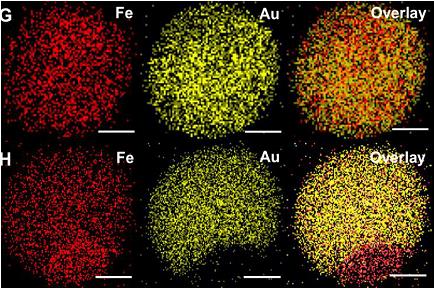
|
in an international collaboration we could demonstrate the synthesis of solid solution fcc AuFe nanoparticles in ambient conditions by an adapted method previously established for a Fe3O4-Au core-shell morphology. The metastable paramagnetic AuFe particles segregate into Janus Au/Fe particles with bcc Fe and fcc Au upon annealing. The results deliver a new material with perspectives in magnetoplasmonics and biomedicine and suggest the reconsideration of existing protocols on magnetite-gold core-shell synthesis. (https://doi.org/10.1039/D1NR00383F) Contact ulf.wiedwald@uni-due.de
|
|
|


































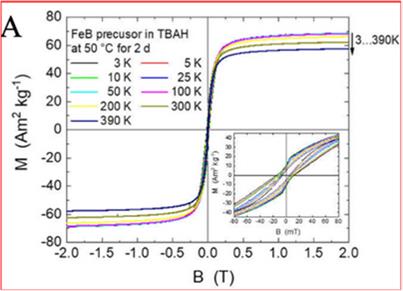




























 New colleague: Dr. Anna Semisalova
New colleague: Dr. Anna Semisalova Young scientists at the University Duisburg-Essen, RWTH Aachen and the Forschungszentrum J�lich organize a symposium at Europe�s largest physics congress. Participants of the DPG meeting in Regensburg are encouraged to join the symposium on 3rd April, 2019. No further registration is required.
Young scientists at the University Duisburg-Essen, RWTH Aachen and the Forschungszentrum J�lich organize a symposium at Europe�s largest physics congress. Participants of the DPG meeting in Regensburg are encouraged to join the symposium on 3rd April, 2019. No further registration is required.
 We welcome Dr. Merivan Sasmaz from the Physics Department, Adiyaman University, Turkey in our group.
We welcome Dr. Merivan Sasmaz from the Physics Department, Adiyaman University, Turkey in our group.
 In 2017 and 2018, PD Dr. Ulf Wiedwald will temporarily exchange the Salvatorkirche for the St. Basil's Cathedral and the Magic Mountain for the Red Square: He prevailed in an international competition and has been appointed as visiting professor at the renowned National University of Science and Technology (NUST) �MISiS� in Moscow, Russia.
In 2017 and 2018, PD Dr. Ulf Wiedwald will temporarily exchange the Salvatorkirche for the St. Basil's Cathedral and the Magic Mountain for the Red Square: He prevailed in an international competition and has been appointed as visiting professor at the renowned National University of Science and Technology (NUST) �MISiS� in Moscow, Russia.











